| GOVERNMENT
OF ALBERTA STRATEGIC BUSINESS PLAN |
| |
| VISION |
 |
“A
vibrant and prosperous province where Albertans enjoy a superior
quality of life and are confident about the future for themselves
and their children.”

|
| |
| INTRODUCTION |
 |
| The
Government of Alberta Strategic Business Plan consists of:
Today’s Advantage, Tomorrow’s
Promise: Alberta’s Vision for the Future
(Alberta’s vision);
Today’s Opportunities, Tomorrow’s
Promise: A Strategic Plan for the Government of Alberta
(20-year strategic plan);
2006-09 Government of Alberta
Business Plan
(Three-year government business plan);
2006-09 Ministry Business
Plans
(Three-year ministry business plans).
Today’s Advantage, Tomorrow’s
Promise: Alberta’s Vision for the Future presents the government’s
vision for the province in the next 20 years, together with the
values of Albertans that support this vision. The vision builds
on three themes – people, preservation and prosperity– and introduces
four strategic opportunities or “pillars” to help achieve the vision:
Unleashing Innovation; Leading in Learning; Competing in a Global
Marketplace; and Making Alberta the Best Place to Live, Work and
Visit.
Today’s Opportunities, Tomorrow’s
Promise: A Strategic Plan for the Government of Alberta
focuses on and supports the vision. It describes Alberta in the
year 2025 and expands on the four strategic opportunities or “pillars”
to realize this vision.
2006-09 Government of Alberta
Business Plan is linked to the fiscal plan and aligns with
the longer-term strategies in the 20-year strategic plan. The three-year
government business plan is published annually and lays out the
government’s goals and strategies and the measures necessary to
track results.
The 2006-09 government business plan
is focused on ensuring that Alberta keeps pace with its projected
economic growth, while sustaining its social and natural advantages.
It outlines a “work order” that includes eight Top Priorities to
manage growth and sets clear expectations for results in each of
these priority areas.
2006-09 Ministry Business Plans
are published annually and cover a three-year planning period. These
plans support both the 20-year strategic plan and the government’s
three-year business plan. The vision and these key plans are aligned
to ensure that all of government is “pulling together” toward shared
goals.
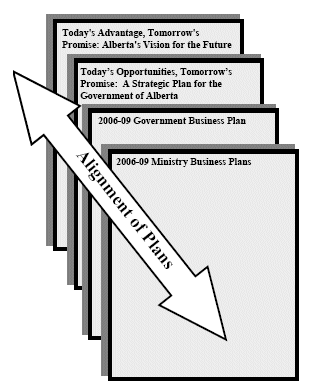
Alberta's vision and the
20-year strategic plan are periodically reviewed and updated to
ensure they continue to reflect the priorities of Albertans.

|
| |
TODAY'S
ADVANTAGE, TOMORROW'S PROMISE:
ALBERTA'S VISION FOR THE FUTURE |
 |
“A vibrant and prosperous
province where Albertans enjoy a superior quality of life and
are confident about the future for themselves and their children.”
Albertans and their government have
created an era of enviable growth and unmatched prosperity. But
neither Albertans nor their government are prepared to be complacent.
The government is focusing on its long-term vision for Alberta,
sustaining close alignment with the directions in the 20-year strategic
plan and addressing both opportunities and challenges in its ongoing
three-year government business plans.

|
| |
| BUILDING
ON SUCCESS |
 |
| In
1993, Albertans faced some tough choices. The economy was not performing
to its potential and the government was spending more than it could
afford. Red tape and regulations were hurting business and government
had become too big. Albertans told their government to take action
and government listened.
Alberta has entered its second century
in an enviable position, with a strong economy, no debt and an unparalleled
quality of life.
Enormous achievements have been realized:
- The economy has grown strongly and
steadily. Alberta’s outstanding economic growth has created over
400,000 new jobs in just 10 years.
- The province currently is experiencing
surpluses due to high oil and gas revenues and has developed a
plan that will ensure over 75 per cent of its 2005-06 surplus
will be invested in endowments for future generations and in the
priority areas that matter most to Albertans: education, health,
infrastructure and the environment.
- Personal and business taxes are
lower.
- Alberta is moving forward on the
Third Way which focuses on new and innovative ways to ensure a
high-quality, accessible and affordable health system for future
generations of Albertans.
- Alberta made a commitment at the
start of its centennial year that advanced education would be
a top priority, and the government introduced the Access to
the Future Act. This legislation will make Alberta’s advanced
learning system a leader in Canada.
- Regulations have been streamlined
and government has become more effective, efficient and adaptable.
Communities, individuals and stakeholders
now want and expect to be full participants in governing the province.
Future-shaping events such as the Public Consultation on a Debt-Free
Alberta, the Premier’s Roundtable on Family Violence and Bullying,
Unleashing Innovation in Health Systems – Alberta’s Symposium on
Health, A Learning Alberta – Dialogue and Directions, and Water
for Life: Alberta’s Strategy for Sustainability have directly involved
individuals, communities and stakeholders in planning Alberta’s
future in priority areas.
The Government of Alberta also has
forged partnerships with communities to find local solutions to
critical issues. From consultation on policy or legislative changes
to community engagement, through such means as community justice
committees, economic development authorities and tourism councils,
community participation is part of everyday life across our province.
In a global environment that is challenging
and chaotic, we must recognize and build on the accomplishments
of the last decade, not rest on them.
Today’s Advantage, Tomorrow’s Promise
envisions Alberta as a place where all Albertans can realize their
full potential, where we work together as stewards of Alberta’s
natural beauty and resources, and where sustained economic growth
leads to continued prosperity and realized opportunity.

|
| |
| KEEPING
ALBERTANS’ VALUES IN MIND |
 |
| The
government’s vision for Alberta fully recognizes the desire of its
citizens to maximize their own achievements and potential as they
take advantage of Alberta’s opportunities. Success requires a strong
foundation, a strength of purpose and a clear sense of Albertans’
values.
The values that provide a strong foundation
to the vision and the government’s 20-year strategic plan are:
- Albertans’ strong belief in the
freedom to pursue personal success;
- Albertans’ recognition that their
right to self-determination is balanced by their responsibility
to their family and to the greater community;
- Albertans’ pioneering, entrepreneurial
spirit and willingness to take risks and embrace new technologies;
and
- Albertans’ desire for the freedom
to control their own lives and their rejection of unnecessary
rules or red tape.

|
| |
| WORKING
TOGETHER |
 |
| Individuals,
communities, non-profit organizations and businesses all have an
important role to play in achieving the vision for Alberta in close
collaboration with the Alberta government.
Government leadership provides the
framework – the fiscal, economic, social and regulatory policies
that will position Alberta to respond to opportunities and address
challenges. Government leadership also promotes Alberta’s interests
and secures benefits for Albertans as an equal partner in a strong,
united Canada.

|
| |
| THE
VISION - ALBERTA IN 2025 |
 |
| What
do Albertans want their province to look like in 20 years? Which
social and demographic trends and which opportunities, risks and
hurdles will determine the type of Alberta we live in by 2025?
Alberta in 2025 will be a province
of four million people, slightly older on average than today’s population
and more diverse. It will be a province where:
- People are free to realize their
full potential and personal choice is the only limit to opportunity;
- Government and industry are responsible
stewards of the province’s abundance of natural resources;
- People feel safe in their homes,
on their streets, in their communities and at work;
- The economic fundamentals of the
province are strong and the tax system is designed to promote
individual entrepreneurship and the transformation to a knowledge-based
economy;
- The economy has shifted toward a
knowledge-based approach, with research, technology development
and value-added products having a much larger part in the province’s
prosperity;
- Essential public services such as
health and education are contemporary, accessible and affordable,
and individuals have a role to play in using these services responsibly;
- The potentially vulnerable in society,
including seniors, children and people with disabilities have
the support they need to live in dignity, achieve personal satisfaction
and independence, and continue to contribute to the betterment
of the province;
- Albertans are able to enjoy the
province’s unspoiled natural areas and wide variety of arts, cultural
and recreational opportunities;
- Aboriginal Albertans have achieved
a socio-economic status equivalent to that of other Albertans;
- The province’s small towns, farms
and ranches are a vital part of Alberta. Rural communities, like
large urban communities, are vibrant and growing;
- The province is a full, participating
partner in Confederation, and the views of Albertans are respected
by the federal government; and
- Municipalities and the provincial
government work in a fair partnership to serve their constituents.
This picture of Alberta in the future
captures the values of Albertans – values that have shaped the province
and its unique place in Canada over the previous century.

|
| |
| THE
VISION'S THEMES - PEOPLE, PRESERVATION AND PROSPERITY |
 |
| Alberta’s
vision, Today’s Advantage, Tomorrow’s Promise, is centred on the
themes of people, preservation and prosperity.
People are at the
heart of the Alberta Advantage. Alberta’s vision rests on the belief
that Albertans are our province’s greatest resource and that their
ability to realize their potential is the cornerstone of the province’s
future.
This requires personal and community
resourcefulness to meet challenges, and support from government
where needed. It requires valuing the diverse gifts that all Albertans
bring to their communities.
Preservation means
maintaining an environment that is unsurpassed in the world while
ensuring sustainable economic growth. Albertans place a high value
on the preservation of a clean, healthy, natural environment, where
the unique beauty of Alberta is protected for future generations
to enjoy.
Prosperity is essential
to maintaining and improving Albertans’ overall quality of life.
Today’s Advantage, Tomorrow’s Promise is a vision to ensure economic
growth that is unmatched in Canada and North America and that ensures
individual Albertans have opportunities to work and succeed. The
vision is based on sound management and sustainable development
of our natural resource-based economy.
Ultimately, however, Albertans will
measure our prosperity as a province by more personal and less tangible
outcomes – the strength and well-being of our families, communities
and society.

|
| |
| ACHIEVING
THE VISION |
 |
| The
vision is achieved through four strategic opportunities or “pillars”
outlined in the 20-year strategic plan – Unleashing Innovation,
Leading in Learning, Competing in a Global Marketplace, and Making
Alberta the Best Place to Live, Work and Visit.
Unleashing Innovation
focuses on Alberta becoming a world leader in innovation, research,
development and commercialization of new ideas.
Leading in Learning
means making sure Albertans have the opportunities they need to
learn, adapt and develop new knowledge and new skills.
Competing in a Global Marketplace
is about creating a business environment that is recognized around
the world as an excellent place to do business.
Making Alberta the Best Place
to Live, Work and Visit is where these strategies translate
into a superior quality of life for Albertans.
Today’s Advantage, Tomorrow’s Promise
is the Alberta government’s vision of an Alberta for Albertans –
a vision developed by listening to Albertans. It is a vision of
unmatched economic prosperity. It is a vision about unleashing the
talents of individual Albertans. It is a vision about maintaining
a clean and healthy environment. And it is a vision where all of
these combine to create an exceptional quality of life.

|
| |
TODAY’S
OPPORTUNITIES, TOMORROW’S PROMISE:
A STRATEGIC PLAN FOR THE GOVERNMENT OF ALBERTA |
 |
| Today’s
Opportunities, Tomorrow’s Promise is a strategic plan that lays
out a course for the Alberta government for the next 20 years. It
identifies four strategic opportunities or “pillars” for Alberta
to maximize its potential, and suggests a number of specific strategies
to take advantage of those opportunities.

|
| |
| AN
ARRAY OF OPPORTUNITIES: A THEME OF SELF-RELIANCE |
 |
| Alberta
is Canada’s high-energy province. It leads the nation in nearly
all economic indicators and is the ideal destination for Canadian
families who are looking to start new careers, open new businesses
and realize their dreams.
For Albertans, economic success is
not an end in itself. Albertans look at economic strength as a key
to achieving their personal goals and to sustaining the advantages
afforded by good health, strong communities and education systems,
low taxes, and a high level of personal freedom and autonomy.
While financial well-being is the anchor
of prosperity, other dimensions of family, social, spiritual and
physical well-being are essential to fulfill human aspirations.
For this province, a strong economy is not merely about numbers
on a spreadsheet. It is also about opportunity and success.
Alberta is blessed with an abundance
of natural resources that have contributed to its economic fortune.
But Alberta’s success is built on more than geography. The vital
ingredient in Alberta’s success story is the hard work and dedication
of the people who make up the province – people who dedicate themselves
to continuous improvement for themselves, their families, their
communities and their province.
Albertans expect their government to
create an environment in which they can maximize opportunities.
For them, government’s job is not to do the work for them; it is
to let them do the work themselves. Albertans call this self-reliance,
and it is a principle that has shaped this province and its people
for more than a century.
This commitment to self-reliance should
not be confused with a lack of caring – for neighbours or for the
province as a whole. Albertans believe that all citizens have the
right to maximize their personal opportunities and the responsibility
to help those who need help.
Self-reliance does not mean that there
are not important expectations for government.
Albertans expect their government to
provide a framework for success through fiscal, economic, social
and regulatory policies that create opportunities. They also expect
that government will work in partnership with Albertans, municipalities,
First Nations, Métis settlements, businesses and others to build
Alberta together.
They expect that government will help
lead the development of the tools for the 21st century economy –
tools such as research, innovation and the development and commercialization
of technology. They expect their government to provide the proper
infrastructure needed for growth and prosperity and to protect the
environment so that Albertans have safe water, air and land today
and tomorrow. Public officials should fund basic services fairly,
avoid big government and manage public dollars wisely.
Over the next 20 years, the government
intends to ensure the province matches or exceeds its record of
success over the previous decade. That is why it has developed this
long-range plan. The plan expands on the province’s vision for the
future and lays out ideas to realize Alberta’s abundant opportunities
and to address its fundamental challenges.

|
| |
| THE
PLAN |
 |
Just
over 13 years ago, in 1993, the province faced deficits and mounting
debt, complex and unnecessary regulatory systems and a government
that had become too big. Albertans and their government developed
a plan to eliminate the deficit, pay down the debt, remove taxes
and regulations that impaired business competitiveness, and refocus
the role of government from direct intervener to partner and facilitator.
Today’s opportunities are different
than those of 10 years ago, and with a solid plan and a commitment
to follow it, Albertans and their government are building on the
foundation created over the past decade.
The plan is based on four strategic
opportunities or “pillars.” Each opportunity is presented separately,
but they are interrelated. Each complements the other, and success
in seizing one opportunity will lead to success in achieving the
others.

|
| |
| Opportunity
1: Unleashing Innovation |
 |
| Over
the past 10 years, Alberta’s economic growth has been unparalleled.
Fuelled by higher-than-expected oil and natural gas prices, annual
economic growth has been strong and consistent.
While natural resource-based industries
will continue to play a vital role in the provincial economy for
many years to come, the province cannot continue to rely on high
natural resource prices forever.
In order to achieve exceptional growth,
Alberta’s economy must expand from its natural resource base, enhance
the value of manufactured goods and business services and venture
boldly into bio-technology, the life-sciences, nano-technology and
other research and development opportunities.
The Alberta government has developed
Securing Tomorrow’s Prosperity to achieve the economic goals of
the strategic plan. It is a market-driven, value-added strategy
with a long-term vision to upgrade primary resources, expand manufacturing,
develop business services and foster knowledge-based sectors. It
also is focused on the growth of a competitive and innovative value-added
and business services industry.
Achieving the New Economic
Promise: A Knowledge-Based Approach
Fostering a knowledge-based economy
means building more value into our traditional goods and services
in order to achieve greater returns from international exports.
It means using technology to make the
most effective use of limited resources and to get the best value
and return for Albertans. It also means building on Alberta’s strong
base of information technology and life sciences to develop and
produce new knowledge-based products.
Over the past decade, the provincial
government has made great strides toward encouraging a broader economic
base. The elimination of needless government regulation has positioned
Alberta as a business-friendly province. Alberta’s strong fiscal
position and favourable personal and corporate tax rates have transformed
Alberta into Canada’s economic powerhouse.
Our 21st century society, composed
of Albertans with roots all over the globe, provides yet another
advantage – windows to the world.
The results have been impressive.
Many large companies have invested
and expanded operations in the province over the last decade, and
Alberta has been cited as the province in which to locate small
businesses. The province’s service and retail sectors have shown
remarkable growth and strength. Alberta companies, large and small,
are trading and providing services all over the world. Alberta’s
labour force is the most productive in Canada.
Great strides have been made, but there
are further opportunities. To ensure that Albertans benefit from
these opportunities over the next 10 years, the Government of Alberta
plans to invest up to five per cent of its annual budget in support
of its innovation agenda, as dollars are available.
The Alberta of 2025 will require an
innovative and productive workforce to keep a strong and
changing economy vibrant. With this in mind, government has worked
closely with a broad range of stakeholders to develop a new Workforce
Strategy. This strategy focuses on a broad range of initiatives
to inform, attract, develop and retain a diverse and productive
workforce for Alberta.
This strategy will examine ways to
promote full participation in the labour market. For example, the
provincial government, in partnership with industry, Aboriginal
communities and other jurisdictions, will develop new strategies
to help Aboriginal people train for, enter and stay in the workforce
and participate fully in the economic opportunities of the province.
The Alberta government also will take
steps to attract skilled workers from outside the province, guided
by a made-in-Alberta immigration policy. Government also needs to
ensure that immigrants to Alberta get full recognition for the professional
qualifications they bring with them in order for them to make the
greatest possible contribution to the province.
One area where more opportunities are
available is in the field of technology development and
commercialization. Alberta’s low business taxes have encouraged
businesses to invest in the province. The availability of research
funding means that significant new technologies are consistently
created in Alberta. Alberta must further develop its capacity for
research, and bridge the gap between basic research and applied
technology.
Often, breakthroughs discovered in
Alberta are developed elsewhere.
Recognizing this, the Government of
Alberta has developed the Accelerating Innovation in Alberta strategy.
Its focus is to encourage innovative Alberta-based companies to
develop technologies and convert them into saleable products in
Alberta. This will require innovation and collaboration among governments,
research institutions, entrepreneurs and businesses.
Another factor in spurring technology
commercialization is the availability of venture capital.
The Alberta government will work with the technology sector and
the investment industry to identify and implement competitive mechanisms
and frameworks to encourage investment and increase access to venture
capital within the province.
Focusing on Our Strengths
Taking a knowledge-based approach will
help Alberta’s economy grow. But Alberta’s traditional strengths
in energy, agriculture, forestry and tourism cannot be forgotten.
The Alberta government has made great
progress in encouraging the development of the province’s traditional
resource-based industries.
The tax and royalty systems have spurred
record investment in Alberta’s oil sands. Alberta’s natural gas
resources have been upgraded through the expansion of the province’s
petrochemical manufacturing base. Research initiatives, business
risk management tools and disaster assistance programs contribute
to the viability of the agricultural sector.
Alberta’s oil sands
are the second-largest deposit of proven oil reserves in the world,
next to Saudi Arabia. The orderly development of these reserves
is vital to Alberta’s future economic prosperity and key to a stable,
secure supply of energy for North America in the 21st century.
The provincial government will ensure
its tax and royalty structures return fair returns to Albertans
while encouraging oil sands expansion.
The government also will continue to
increase its investment in research aimed at more innovative and
efficient ways of extracting oil from the oil sands; for example,
technology that reduces the use of natural gas in oil sands production
processes.
The Alberta government also will stimulate
new petrochemical investment by working with industry to develop
new feedstock supplies through integration with oil sands upgrading
and processing.
Another vital resource to Alberta is
natural gas. Though abundant, Alberta’s natural gas reserves are
not unlimited. Albertans must find ways to improve natural gas recovery
and use natural gas more efficiently and effectively.
Toward this end, the government will
actively encourage the extraction of coal bed methane – a valuable
source of natural gas in coal, but one that is more difficult to
extract. Natural gas in coal has the potential to offset declining
conventional natural gas reserves, just as oil sands production
is offsetting the decline in production of Alberta’s conventional
oil reserves.
The Alberta government also is considering
further investments in research to turn carbon dioxide into a marketable
product. Development of new technologies and the construction of
a carbon dioxide pipeline could mean that carbon dioxide becomes
a valuable resource in the extraction of conventional oil or natural
gas in coal. Such uses also would reduce greenhouse gas emissions
from Alberta’s oil sands.
The government will focus its efforts
to ensure the northern natural gas pipeline can meet the demand
for natural gas required to operate Alberta’s oil sands production
capacity.
Alberta also is fortunate to hold vast
amounts of high-quality coal. The government will
continue to invest in and promote research into making Alberta’s
already clean coal into an even more environmentally friendly source
of energy.
The Alberta government has been a leader
in the use of green power, having obtained 90 per
cent of our power requirements for provincial government buildings
from green power commencing January 1, 2005. Following this lead,
the government will develop measures to encourage private-sector
investment in green power technologies.
Finally, the government will help the
forestry and agriculture industries expand the
value-added component of these industries and provide customers
with high-quality, safe and nutritious foods and value-added forest
products. For example, through its Life Sciences Strategy, the government
is building on the province’s research and innovation strengths
in key sectors such as agriculture, energy, environment, forestry,
health, and information and communications technology.
Using Natural Resources Wisely
Over the past two decades, great strides
have been made to take advantage of Alberta’s natural resources
for the benefit of all Albertans. Development of the oil sands has
created an enormous supply of increasingly economical oil that Alberta
exports to the world. Alberta’s natural forests have been harvested
in a sustainable and environmentally responsible way. The province’s
landscapes support increasing recreation and tourism.
With finite resources, Albertans must
make sure that these resources always are put to the best possible
long-term use.
Toward this goal, the provincial government
will ensure that the province’s land base is used
as effectively as possible, recognizing traditional and different
possible users, for the benefit of all Albertans. The government,
in consultation with Albertans, will develop a comprehensive land
use framework for the province.
There are limits to Alberta's available
water supply. Our quality of life and economy require a long-term
approach to water management; therefore, the Government
of Alberta is implementing a comprehensive water strategy. Water
for Life: Alberta's Strategy for Sustainability advances a watershed
approach to water management. This strategy encompasses a broad
range of tools to ensure reliable, quality water supplies to maintain
healthy aquatic ecosystems over the long term, as well as a sustainable
economy.
Alberta’s conventional oil and gas
reservoirs have significant volumes that can be extracted using
enhanced recovery techniques. To obtain the most from our finite
resources, the provincial government will develop an enhanced recovery
strategy to extend the life of these resources.
Overall, a thriving Alberta economy
requires a system in which the competition for finite resources
is always decided in favour of Albertans as a whole. The provincial
government is responsible for ensuring that competing interests
are managed for the benefit of all Albertans.

|
| |
| Opportunity
2: Leading In Learning |
 |
| At
the heart of self-reliance, and of any person’s success, is his
or her desire to learn. Whether they are in school, learning on
the job, or volunteering in their communities, Albertans desire
to learn and improve. And, they want the opportunity for their children
to be the best they can be. Albertans know that education is the
best investment they can make in the future.
Government’s role is to ensure an excellent,
accessible and affordable learning system that meets the needs of
learners, society and the economy. Participation in education is
a shared responsibility of learners, parents, stakeholders, the
general public and the government. The learning system must support
the development of the province’s human capital to ensure Alberta
is a leader in the knowledge-based world.
Albertans know that investment in education,
and supports to ensure children’s readiness to learn, is a direct
investment in the province’s future. For government, the goal for
the basic education system is to give students of all ages the opportunity
to achieve their full potential.
The Alberta government is continuing
work on government-supported recommendations from Alberta’s Commission
on Learning. The report has provided guidance and direction to government
and the Kindergarten to Grade 12 education system in order to ensure
that the system meets the needs of all Alberta students and is affordable,
with sustainable funding over the long term.
For many people, formal education does
not end with grade 12. Alberta is among Canada’s leaders when it
comes to the proportion of the population that pursues lifelong
learning opportunities.
Alberta has increased investment to
expand learning opportunities and create more spaces at Alberta’s
universities, colleges and technical institutes, and has held public
dialogues on future directions in advanced learning. These dialogues
have resulted in a new vision and framework to guide the development
of Alberta as a learning society where individuals can reach their
potential.
Education helps individuals achieve
their goals. Equally important is the fact that education helps
the province prosper. These new strategies will help to make Albertans
competitive in the global market and ensure full participation in
Alberta’s communities.

|
| |
| Opportunity
3: Competing In A Global Marketplace |
 |
| Because
Alberta is a major exporter of goods and services, an important
strategy for the government is to ensure reliable export
markets. Alberta individuals and companies export their
goods and services across Canada, North America and the world.
Seamless access to the United States,
Alberta’s largest and most important trading partner, is essential.
Alberta will work with the federal
government to examine the feasibility of a customs union with the
United States. A customs union would result in common border practices,
harmonization of trade policies and regulations, and an end to the
use of trade remedies within North America. A customs union would
strengthen Canada’s overall trade relationship with the U.S. and
reduce interruptions to Alberta’s access to U.S. markets.
The Alberta government also is committed
to maintaining and improving its relationship with the U.S. An Alberta
office has been established in Washington, D.C. to ensure Alberta’s
interests are promoted within the U.S.
It also is important to strengthen
partnerships within Alberta and Canada. The Alberta government will
develop effective partnerships to expand trade and build a stronger
investment climate.
Protecting what Albertans achieve
is vital to stimulating continued economic strength. Alberta
is an important member of Confederation. Albertans are proud Canadians
who believe strongly in their country. But Alberta’s interests are
not always taken into account by the federal government. Federal
programs and policies sometimes have a negative effect on Albertans
and the Alberta economy.
The provincial government will continue
to work to ensure Albertans are treated fairly within Confederation.
The province will work with other provinces
to ensure that the federal government respects provincial jurisdiction
and does not take measures that would hurt Alberta’s economy or
Albertans’ quality of life. This includes ensuring regular First
Ministers’ meetings with the federal government, provincial participation
in international negotiations that affect provincial interests and
working toward a Triple E senate.
The government also will work to ensure
that external influences do not jeopardize Alberta’s ability to
benefit from its invaluable natural resources, such as oil, gas
and coal. The Alberta government will consider carefully all measures
that could be taken to ensure provincial interests are protected
within Canada and abroad.
Alberta’s agriculture industry, a cornerstone
of Alberta life for many years, is under pressure from various sources.
Generally declining commodity prices will continue to put pressure
on all sectors of the industry. Market access in the face of bovine
spongiform encephalopathy (BSE) disease has caused significant harm
to Alberta’s beef industry. These impacts, combined with severe
weather and dry conditions, continue to threaten this sector.
The Alberta government will combat
the forces negatively affecting the agriculture industry through
a variety of measures. Specifically, the government will work to
ensure access to foreign markets by strengthening relations with
the U.S. and by ensuring Alberta’s meat inspection processes are
the best in the world. Expansion of the province’s meat-processing
industry is important to ensure that beef products are packaged
in Alberta before being shipped to export markets.
The Alberta government also will ensure
its water and land use policies allow the industry to prosper. It
will continue to invest in research directed at improving the efficiency
of agricultural operations and ensure that value-added products
are exported at their highest development potential.
Alberta’s forestry
industry is facing external pressure due to U.S. countervailing
duties. The Alberta government is committed to strengthening relations
with the U.S. in order to resolve current issues and avoid future
problems.
The government also will promote tourism
development through its comprehensive land use policy and by informing
Canada, North America and the world about Alberta’s spectacular
tourist destinations.
A leading economy requires leading
public infrastructure and transportation. Modern
infrastructure and transportation systems are essential to attract
investment and skilled workers. Efficient electric transmission
lines and oil and gas pipelines, well-equipped health facilities,
good schools and post-secondary facilities, high-quality water systems
and safe and modern roads are key factors to a strong economy.
The government will continue to work
with local governments, economic development authorities, industry
and others in the community to ensure infrastructure and transportation
systems support economic and demographic growth.
The government will continue to place
a priority on planned, stable capital expenditures through the use
of these mechanisms. This includes making funds available for timely
maintenance and preservation of our capital assets and taking advantage
of new approaches to funding capital projects, such as public-private
partnerships. Alternative financing options will be used only if
they make economic sense and if they get new infrastructure and
transportation on stream efficiently and quickly.
In order to remain globally competitive,
Alberta must also work towards continued improvement in productivity.
A competitive tax system, improvements in workplace health and safety,
positive labour-management relationships, the development of new
technologies and the removal of unnecessary legislative impediments
will enhance the productive competitiveness of Alberta industry.
The Alberta government will continue
to support an environment in which small businesses
can succeed. This means keeping taxes low and eliminating unnecessary
rules and regulations. Albertans – always innovative, always willing
to take risks – will do the rest themselves.

|
| |
| Opportunity
4: Making Alberta The Best Place To Live, Work And Visit |
 |
| Albertans
have come to expect high-quality social programs and services, and
the Alberta government remains committed to providing them.
Over the next 20 years, Albertans and
their government will face some significant challenges in improving
upon the high-quality services Albertans expect.
For example, the real cost of providing
quality health care will continue to grow. Over the past 10 years,
per capita health care costs have outpaced inflation and economic
growth. As the population ages, pressures on health and related
services, including the cost of new drugs and technologies, are
expected to increase. Albertans know that constantly pouring greater
and greater amounts of money into health care does not guarantee
the sustainability of the system; in fact, it threatens it.
Similarly, the costs of providing Alberta
students with a quality education and support services to children
and families also are rising.
Government must make sure that its
revenues are sufficient to meet the costs of these programs and
must take steps to keep these programs affordable and sustainable
without sacrificing quality. Innovation will play an important role
in improving services for Albertans.
Ensuring Adequate Revenue
The Alberta government has taken some
steps over the last decade to make sure adequate revenues are in
place to fund programs and services.
The Sustainability Fund was created
to cushion spending plans against revenue volatility, resulting
in improved predictability in program funding from year to year.
Most importantly, paying down the provincial
debt has freed up funds for programs and services – funds that otherwise
would have gone to debt-servicing costs.
But the potential for a decline in
natural resource royalty revenues means that the Alberta government
must take additional steps to ensure revenues are adequate to meet
Albertans’ expectations. The Alberta government will continue to
monitor the tax regime and set out fiscal policies with the temporary
nature of resource revenues in mind.
Improving Services for Tomorrow’s
Albertans
To ensure Albertans can continue to
enjoy the level of services that are currently provided and enhance
services in other areas, innovative ways of funding and delivering
programs and reducing costs, where possible, are required.
The Alberta government has taken significant
steps to improve the efficiency, effectiveness and economies of
program and service delivery over the past 10 years. For example,
administrative costs for health care have been streamlined significantly.
Providing some publicly funded health services in modern, private
clinics rather than in expensive hospital settings, coupled with
new drugs and technologies, has improved patient service. Programs
such as the Health Link and primary care initiative provide new
ways for Albertans to access health services quickly.
The provincial government also has
improved service delivery through the development of a well-educated,
service-oriented, innovative and motivated public service.
But even with these improvements, new
methods of program delivery and funding are required. Government
must maintain responsibility for setting policy and monitoring outcomes
to ensure the desired results are achieved. Programs should be delivered
by those best able to deliver them effectively and efficiently,
whether government, the private sector, non-governmental organizations
or partnership among these parties.
Health care. Alberta’s
health care system has undergone a number of changes in the past
10 years. Regional health authorities, health providers and community
partners have worked together to improve access, streamline services,
open up new approaches to care and respond to the needs of Alberta’s
fast-growing population.
The government has committed to a Third
Way to further evolve the health system for the future.
This is why Alberta hosted an international
symposium on health. Unleashing Innovation in Health Systems: Alberta’s
Symposium on Health brought some of the world’s leading experts
in health systems innovation to Alberta to present their ideas to
health system leaders, providers and stakeholders.
There is no single solution to the
challenges of our health care system. Instead, it is important to
move ahead with hundreds of ideas and improvements that meet patients’
needs and make a positive difference in the health of Albertans.
As a step in this direction, the Alberta
government will evaluate alternative ways to finance programs not
covered by the Canada Health Act, such as long-term care
and prescription drugs, and explore cost-sharing approaches to a
wide range of services. Working with health care providers, the
government is promoting healthy living and wellness and making services
more efficient and accessible for all Albertans.
As well, there is an important emphasis
on recognizing the impact of health research and technology on the
community as an economic driver – as a benefit, not just a cost.
Services to Alberta’s children
are not only an important service to those in need, they are also
an investment in the human potential of the province. Getting a
healthy start in life is critical to the success of Alberta’s children
and the realization of Alberta’s vision for 2025.
The Alberta government will continue
to place a priority on children’s services, especially those services
that are designed to enable children to succeed at learning. A significant
focus will be placed on programs that promote early childhood development
and other prevention strategies to support families in promoting
the optimal development of children.
Overcoming barriers to success at an
early age will help children achieve and help society avoid the
cost of lost potential. Community partnerships provide leadership
in helping young Albertans succeed.
Helping those in need
is essential to Alberta’s success. More importantly, Albertans want
to be sure that fair and compassionate programs are available for
those who need some support.
Barriers to full participation in the
province’s economic and community life can result in limited opportunities
and contribute to poor health status. Children from low-income families
may not enter school ready to learn. Aboriginal children and communities
may require support to ensure the gap is closed between the socio-economic
status of Aboriginal and non-Aboriginal Albertans. Children from
new Canadian families may face literacy challenges as well as a
lack of training in English as a second language. Persons with disabilities
and seniors may face financial challenges, lack access to affordable
housing or lack the necessary supports for independence.
The Alberta government will encourage
initiatives that assist families and support children to realize
their potential, enhance the participation of Aboriginal people
in the Alberta economy, and ensure that seniors and Albertans with
disabilities enjoy adequate incomes and the supports necessary for
independence.
Continuously Improving Quality
of Life
The stimulation of Alberta’s economic
growth will enable the province to fund essential services, which
in turn helps create a high quality of life.
However, quality of life is more than
a growing economy and good social programs. It is also about people
being able to realize their dreams, feeling safe in their homes
and on their streets, knowing their natural environment is protected,
and being enriched by cultural, sport and recreational opportunities
in their neighbourhoods.
The Alberta government is committed
to making investments in all of these factors that contribute to
the overall quality of life for all Albertans.
Strong municipalities
are an essential part of a strong Alberta. The provincial government
will continue to work toward enhancing its relationships with its
local governments. Ensuring that the roles and responsibilities
of local governments are well defined means that municipalities
can continue to be responsive to the needs of their communities
and remain financially strong and viable.
Vibrant rural communities
also are essential to the province’s economy and overall quality
of life. The Alberta government will implement its Rural Development
Strategy, A Place to Grow, that assures dynamic rural communities
where families, individuals, organizations, businesses and governments
are contributors to the growth, prosperity and quality of life of
Albertans.
Alberta SuperNet provides an electronic
highway to hundreds of communities, making it possible for businesses
and individuals in rural areas to compete globally. Health services
and educational opportunities will be enhanced by new technologies.
The economic opportunities of the Calgary-Edmonton
corridor can be distributed more widely with appropriate infrastructure
and transportation.
Safe communities are
critically important to the well-being of Albertans and their children.
The Alberta government will continue to invest in Alberta’s communities
to make them among the safest in North America. Government will
focus on the continued reduction of violent crime by improving its
commitment to policing and getting tougher on those who commit violent
offences.
The Alberta government has committed
to an integrated, community-based approach to preventing and responding
effectively to family violence and bullying. The Premier’s Roundtable
on Family Violence and Bullying has developed a strategy that will
improve the capacity of communities to respond to one of our province’s
most serious social issues. It proposes solutions that focus on
families, schools, communities and regional collaboration.
The government is taking strong action
to tackle the issue of crystal methamphetamine. Initiatives will
include a focus on prevention, increasing the availability of addictions
services and legislative responses.
The government will play a leadership
role in establishing a more responsive justice system by focusing
on preventative strategies, expanding the availability and scope
of dispute resolution options and using technology to facilitate
access to justice services.
The Alberta government will help build
safer communities by involving the communities themselves, along
with the private sector, families and individuals. It also will
continue to pressure the federal government to take tough positions
against violent crimes and those who commit them.
Safety is not limited to protection
from crime. Albertans need to feel safe in their homes, at work
and at play. To provide this assurance, the government supports
programs and initiatives for safety standards, injury prevention
and safety on our streets, promoting partnerships wherever possible.
World events have highlighted a need
to provide security from threats of a global nature. The Alberta
government will continue to focus on mitigating, preparing for,
responding to and recovering from major emergencies and disasters
at the provincial and local levels. The government will continue
development of a world-class security and emergency preparedness
framework for the province.
A clean natural environment
and a vibrant cultural mosaic are other key components
of ensuring a high quality of life. This includes ensuring Alberta’s
natural areas remain unspoiled and protecting the quality of Alberta’s
air, lakes and rivers.
The Alberta government will place a
priority on Alberta’s quality natural environment by developing
a framework for maintaining its existing natural areas. The implementation
of the government’s new water strategy will provide for the continued
high quality of Alberta’s lakes, rivers and streams and also will
address water conservation challenges.
The Alberta government also will develop
strategies that encourage innovative solutions on climate change
and ensure a balanced and sustainable approach to growth and industrial
and resource development.
Alberta's vibrant, artistic and cultural
mosaic not only enriches the lives of all Albertans, but also opens
the doors to more international trade opportunities. The Alberta
government will continue to value the province's artistic and cultural
diversity by providing support for community needs.
Albertans value their personal
and economic freedoms. Over the past 10 years, the provincial
government continuously has reviewed its programs, policies, regulations
and legislation to ensure it is not interfering needlessly in the
lives of Albertans. This requires a continuous commitment to review
programs and end government involvement in areas that can be better
delivered by others.
Government also must ensure that it
does not waste time and resources in providing services that should
be the responsibility of individual Albertans.
To that end, the Alberta government
will continue to review its regulatory systems to ensure that Albertans
are not over-regulated and businesses can continue to thrive. If
it finds laws or rules that make no sense, it will abolish them.

|
| |
| CONCLUSION:
BUILDING ON ALBERTANS' SELF-RELIANCE |
 |
| This
plan for Alberta’s future is based on a truly Albertan characteristic
– a dedication to strong individuals within strong communities.
The Alberta government is committed fully to the values and vision
on which this plan was built. This plan was developed with advice
from people from across the province. The government will continue
to work with Albertans, including the private sector, communities
and non-governmental organizations, to refine the plan in order
to ensure it continues to reflect the changing environment in which
Albertans live.

|
| |
| 2006-09
GOVERNMENT OF ALBERTA BUSINESS PLAN |
 |
| The
2006-09 Government of Alberta Business Plan is focused on ensuring
that Alberta keeps pace with its projected economic growth and becomes
an even better place to live, work and raise a family.
This three-year government business
plan advances the four strategic opportunities of the government's
20-year strategic plan: Unleashing Innovation; Leading in Learning;
Competing in a Global Marketplace; and Making Alberta the Best Place
to Live, Work and Visit.

|
| |
| MANAGING
OUR GROWTH AND SECURING OUR FUTURE |
 |
| The
2006-09 government business plan addresses the significant opportunities
and challenges facing the province over the next three years. For
one, Alberta is expected to continue enjoying the strongest economic
growth of any province in Canada. The annual rate of growth is projected
to average around four per cent over the next three years. There
are over $120 billion in capital projects planned or in progress
in Alberta. While this level of economic activity is contributing
to population growth and the high quality of life in Alberta, it
also generates growing labour shortages and puts pressures on our
environment and infrastructure. Managing this growth is the most
significant challenge facing the province.
Secondly, the province can expect further
surpluses driven by higher energy revenues. However, energy prices
remain volatile and it is difficult to know today how much additional
revenue will be available in the future. If we want our children
to enjoy the quality of life we have now, we must manage these surplus
resource revenues in a responsible manner. That is why over 75 per
cent of the 2005-06 surplus was invested in the future. The province
will continue to set aside a significant portion of each year’s
surplus for endowments to support long-term priorities that will
benefit Albertans for generations to come. It is also investing
in infrastructure, education, health and other current priorities
identified by Albertans. These strategic investments in roads, schools,
hospitals and other capital projects are critical for Alberta’s
communities now and for the future.
Thirdly, the social fabric of Alberta
is changing. Our population is aging. Alberta is becoming more urbanized
and more culturally and ethnically diverse as the province’s advantages
attract thousands of people from other parts of Canada and the world
every year. At the same time, rural Albertans are emphasizing the
need for vibrant rural communities and a stronger, more resilient
agricultural sector. The government is addressing these priorities
through A Place to Grow, its Rural Development Strategy. Alberta
has committed to advance learning for all Albertans as a cornerstone
to building the innovative, knowledge-driven economy we need to
sustain future prosperity in all parts of the province.
Finally, Alberta is poised to affirm
its place in Canada and in the world as an innovative, entrepreneurial
leader. From breakthroughs in medical research to technological
advances in new and emerging sectors to job growth, Alberta’s successes
contribute to a stronger Canada in diverse and exciting ways.
To take full advantage of Alberta’s
opportunities and to meet its challenges, the government has outlined
a “work order” focused on eight Top Priorities over the next two
years. These priorities are:
- Building and Educating Tomorrow’s
Workforce;
- Improving Alberta’s Health System
– The Third Way;
- Building Infrastructure for Our
Future;
- Using and Respecting the Land;
- Building Aboriginal Self-Sufficiency;
- Saving Lives and Reducing Injury
on Alberta’s Highways;
- Reviewing Tax Policy; and
- Protecting People’s Private Information.
The three-year government business
plan provides actions for these eight Top Priorities and outlines
the 14 goals and supporting strategic priorities set for the 2006-09
planning period.
The 2006-09 government business plan
positions Alberta to make the most of its economic, social and natural
advantages. It is a plan for strategic management of our province’s
growth and a plan for securing its future.

|
| |
| FOCUS
OF THE THREE-YEAR PLAN: EIGHT TOP PRIORITIES |
 |
| The
Government of Alberta has outlined eight Top Priorities as the focus
of the 2006-09 government business plan. Although each of these
priorities contributes significantly to the achievement of one or
more of the 14 goals outlined in the business plan, each is aligned
only with the goal to which it is most stongly related. These priorities
will be achieved through close collaboration and cooperation across
a number of ministries.

|
| |
| Building
And Educating Tomorrow's Workforce |
 |
| (Aligns
with Goal 1)
Alberta is facing a number of demographic
trends – an aging population, low birthrate, urbanization, and slowed
interprovincial migration – all of which are affecting our ability
to meet the labour force demands of a rapidly growing economy. Projections
suggest Alberta will face a shortage of 100,000 workers over the
next ten years. Alberta must cultivate and attract people with the
skills to meet diverse needs in order to sustain its future economic
growth.
Actions
- Develop and approve a refocused
and coordinated labour force development strategy that addresses
emerging and critical labour needs.
- Implement the Access to the
Future Act to enhance the quality of advanced learning opportunities
and to encourage more innovation in the advanced learning system.
An Access Advisory Council will be established and the first earnings
from the Access to the Future Fund will be distributed.
- Implement recommendations from A
Learning Alberta Forum with a focus on improving affordability,
accessibility and quality of learning opportunities for adult
Albertans.

|
| |
| Improving
Alberta's Health System - The Third Way |
 |
| (Aligns
with Goal 5)
While Albertans value the health care
they receive, providing timely access to quality health services
is increasingly challenging. The growing cost of the health system
also needs to be addressed. Improving Alberta’s public health system
is a priority for the government, with a focus on enhancing accessibility,
quality and sustainability and improving the overall health status
of Albertans.
Actions
- Develop a child and youth wellness
strategy to address the health, well-being and mental health of
children.
- Increase the availability of addictions
services and take specific and targeted action to tackle the crystal
methamphetamine problem. • Develop and implement a common pharmaceutical
framework to control spiraling drug costs and increase coverage.
- Develop and implement strategies
to improve the quality of long-term care.
- Develop recommendations for an insurance
program that considers coverage of continuing care, prescription
drugs and other non-emergency health services.
- Implement a province-wide electronic
health record that provides diagnostic imaging test results.

|
| |
| Building
Infrastructure For Our Future |
 |
| (Aligns
with Goal 14)
Population growth and a booming economy
are challenging the province’s public infrastructure. The backlog
in infrastructure maintenance needs to be addressed. A comprehensive
plan to address existing infrastructure needs and future investment
in infrastructure is key to supporting future economic growth.
Actions
- Develop a 10-year comprehensive
capital plan to address existing deferred infrastructure maintenance
and future investment in new infrastructure projects.
- Complete the CANAMEX Trade Corridor
to support increased north/south trade.
- Improve the Fort McMurray highway
corridor to address public safety and traffic capacity.
- Construct Calgary and Edmonton ring
roads.

|
| |
| Using
And Respecting The Land |
 |
| (Aligns
with Goal 1)
Urbanization, population growth and
a strong economy have combined to increase pressure on and competition
for use of Alberta’s natural resources. Effective management of
the competing interests of surface and sub-surface development,
agricultural production, urban settlement, watershed management,
recreation and preservation of natural beauty and wildlife habitats
is critical to Alberta’s high quality of life and continued economic
prosperity.
Actions
- Develop an Alberta Land Use Framework
for effective management of competing land use interests.
- Continue to implement the Water
for Life Strategy to support a healthy and sustainable water supply
for communities, for the environment and for Alberta’s economic
well-being.
- Improve monitoring and reporting
and provide better access to reliable information on our resources
and environment.
- Promote research, development and
commercialization to improve extraction, upgrading and refining
of Alberta’s hydrocarbon resources and reduce environmental impacts.
- Position Alberta as a leader in
adapting and integrating clean coal technology to provide an energy
source to produce electricity, heat, hydrogen, fuels, chemical
feedstocks, and in the future move CO2 to support enhanced
oil recovery, with near zero or minimal environmental impacts
on land, air and water.

|
| |
| Building
Aboriginal Self-Sufficiency |
 |
| (Aligns
with Goal 7)
Alberta’s Aboriginal, First Nations
and Métis peoples are the fastest-growing demographic group in the
province. Aboriginal people have a key role to play in Alberta’s
economic prosperity as well as in determining the future direction
of their communities. Alberta is currently involved in self-government
negotiations with the First Nations and the federal government.
Alberta’s negotiators are committed to ensuring the best interests
of all Albertans are served in this important process. At the same
time, there is no clear regulatory regime on reserves to regulate
economic and resource development. This discourages much-needed
investment in on-reserve development. Clarity in this area is needed
to improve opportunities for Alberta’s Aboriginal communities on
reserve.
Actions
- Implement a framework to guide provincial
participation in self-government negotiations with the federal
government and First Nations.
- Establish regulatory mechanisms
to enable economic activity on reserve.

|
| |
| Saving
Lives And Reducing Injury On Alberta Highways |
 |
| (Aligns
with Goal 10)
The societal cost of traffic injuries
and fatalities, including health care, policing, property damage
and lost work, is very high. In 2003 alone, traffic collisions in
Alberta claimed 385 lives and caused 26,426 non-fatal injuries.
The Government of Alberta is making Saving Lives and Reducing Injury
on Alberta Highways a priority because traffic collisions can be
prevented. Saving lives and preventing injuries will benefit thousands
of families, communities and businesses in all corners of the province.
Actions
- Develop and implement a Traffic
Safety Plan, which provides a coordinated approach for the development
of new strategies, including legislation and increased enforcement.
- Through coordinated leadership,
specifically address issues such as traffic safety, driver education
and licensing, enforcement, technology and sustainable funding.

|
| |
| Reviewing
Tax Policy |
 |
| (Aligns
with Goal 8)
Various tax policy options have been
considered over time in order to ensure Alberta’s tax system remains
competitive. Tax policy decisions need to balance competitiveness
with the need to ensure that the tax base is sufficient to support
the province’s programs.
Action
- Build on results of the current
tax review to ensure tax competitiveness, economic efficiency,
fairness and revenue stability.

|
| |
| Protecting
People's Private Information |
 |
| (Aligns
with Goal 10)
As governments, citizens and businesses
increasingly seek greater coordination, integration and automation
to improve service delivery, all reasonable measures must be taken
to ensure personal information is managed with the highest standards
of security.
Action
- Develop a government-wide strategy
to ensure personal information entrusted to government is managed
to ensure privacy and security.
These eight top priorities comprise
a clear and concise “work order” and the government will be accountable
to Albertans for making significant progress on these eight priorities
in the 2006-09 business plan.

|
| |
| BEING
ACCOUNTABLE TO ALBERTANS |
 |
| The
Government of Alberta Business Plan is an ongoing three-year plan
that is part of the government’s commitment to be open and accountable
to the people of Alberta.
The Government Accountability Act
requires that the government annually publish a three-year consolidated
fiscal plan that includes a three-year consolidated capital plan
for the government and a three-year government business plan. The
Act also requires that the government annually publish the results
of its performance against the performance measures targets established
in the three-year government business plan and to explain significant
variances from the targeted results.
Performance results for the 2006-09
government business plan will be published in the Measuring Up report
released as part of the 2006-07 Government of Alberta Annual Report
at the end of June in 2007.
Core Businesses and Goals
The 2006-09 government business plan
has 14 goals that are broad statements of what the government is
trying to achieve in each of its core businesses and with its capital
investment. The government’s core businesses encompass its principal
areas of responsibility and are linked to one or more of the government
goals. They provide a functional breakdown of the work the government
does for Albertans and are the primary categories for allocating
budgetary resources. The core businesses are summarized in the Expense
by Core Business table and Core Businesses Key in the Appendix.
The goals should not be considered
in isolation. Progress toward one goal often results in progress
being made toward other goals. Furthermore, the government cannot
achieve the goals alone. The government works in partnership with
other levels of government, communities, businesses, industry, and
not-for-profit sectors toward the achievement of Alberta’s goals.
Each of the government’s goals provides
information about the government’s priorities for the next three
years and what resources will be used in working toward the goal.
The information is presented in the following sections: What it
means; Three-year strategic focus; Link to ministry business plans;
What it costs; and Measures.
What it means
Each goal includes a “What it means”
section that describes the goal from the government’s perspective
and provides context for the goal statement. It also directs readers
to related goals in cases where the government’s work toward achieving
the goal affects progress toward other goals in the three-year government
business plan.
Three-year strategic focus
The “Three-year strategic focus” section
summarizes the government’s strategic priorities for each of the
goals.
Strategic priorities are major initiatives
that the government will undertake during the next three years,
over and above ongoing program and service delivery responsibilities,
to address significant opportunities and challenges related to the
goals. Although more than one ministry is usually involved in working
to address a strategic priority, only the lead ministry (or ministries)
is shown. More detailed information is available in the three-year
business plans of the ministries that are linked to the strategic
priorities.
These strategic priorities include
the eight Top Priorities that are the focus of the 2006-09 government
business plan. Although the Top Priorities support more than one
of the 14 goals, each is listed only under the goal to which it
is most strongly related.
Link to ministry business plans
Each goal has a “Link to ministry business
plans” section that lists the ministries that contribute financially
to achieving the goal. The Expense by Goal by Ministry, 2006-07
Estimate table in the Appendix provides a breakdown of ministries’
planned spending for the government goals.
Additional information about the work
government is doing to achieve its goals is provided in the three-year
business plans of the ministries that are linked to each goal. Ministries
indicate how their business plan goals relate to and support the
government goals in the “Link to the Government of Alberta Strategic
Business Plan” section of their three-year government business plans.
Ministry business plans are an integral part of the Government of
Alberta Strategic Plan and are published in the Business Plans volume
of the Budget.
What it Costs
The “What it costs” section for each
goal shows the annual provincial spending directed at achieving
the goal. The first 13 goals are linked to the government’s 2006-09
Fiscal Plan through the expense by function (core business) breakdown
of the government’s spending. The Expense by Goal table in the Appendix
summarizes the planned spending for the first 13 goals over the
next three years.
Goal 14 has a different perspective
than the other goals. It is the government’s goal for its investment
in the province’s infrastructure, which provides essential support
for achieving all of the government’s goals. Goal 14 is linked to
the government’s 2006-09 Capital Plan that includes the total value
of capital being acquired or directly supported by the provincial
government. The Capital Plan includes spending from across the government’s
core businesses in the form of grants to local authorities, as well
as investment in provincial government-owned capital and the value
of projects being alternatively financed.
Measures
The “Measures” section of each goal
includes two groups of measures: societal measures and performance
measures.
Societal measures track broad social
and economic trends in the province. These measures are influenced
by numerous factors that are outside of government and should be
viewed as measures of the province’s well-being, taking into account
all of the influencing factors both within and outside of the province.
The efforts of individual Albertans,
business and industry, communities, not-for-profit groups and other
levels of government also play an important role in contributing
to the province’s well-being and influence the results of societal
measures. To show the recent trend for these provincial measures
of well-being, societal measures are presented in the business plan
with five years of results and the desired results that indicate
progress toward the goal.
Performance measures track what the
government would like to achieve in making progress toward the goal.
These measures are presented in the business plan with the last
actual results and targets for each of the three years of the plan.
Targets for performance measures are
established based on what the government would like to achieve given
previous results, budgeted resources and the expected effects of
significant factors that influence the results for the measures.
Results for performance measures, including a discussion of the
effects of significant factors, will be published in the 2006-07
Measuring Up report.
Taken together, the societal and performance
measures help the reader to assess the current well-being of the
province with respect to the goals and whether the government’s
overall initiatives are effective in contributing to achievement
of the goals in the short-term and over time.

|
| |
| UNLEASHING
INNOVATION |
| |

Alberta will have a diversified and prosperous economy |
| |
Sustainable economic growth and prosperity
are essential to maintaining and improving Albertans’ overall quality
of life. Innovation, value-added diversification and global competitiveness
are key for sustaining the momentum of Alberta’s economy. (Progress
toward Goal 1 results in progress being made toward achieving Goals
2, 3 and 8.) |
Three-year
strategic focus |
|
The following strategic
priorities address significant opportunities and challenges facing
the government. A checkmark ( )
indicates one of the eight Top Priorities of the three-year government
business plan. See the three-year business plans of the ministries
shown in brackets for further information. )
indicates one of the eight Top Priorities of the three-year government
business plan. See the three-year business plans of the ministries
shown in brackets for further information.
 Building and Educating Tomorrow’s Workforce –
Work with partners and stakeholders on strategies to help ensure
that Alberta has an innovative, well-educated, skilled and adaptable
population that will support economic and social prosperity and
maximize Alberta’s competitive edge in the global economy. (This
priority also supports Goal 2.)
Building and Educating Tomorrow’s Workforce –
Work with partners and stakeholders on strategies to help ensure
that Alberta has an innovative, well-educated, skilled and adaptable
population that will support economic and social prosperity and
maximize Alberta’s competitive edge in the global economy. (This
priority also supports Goal 2.)  Using and Respecting the Land (Sustainable Resource
Development; Energy; Environment; Municipal Affairs; Community
Development; Aboriginal Affairs and Northern Development; and
Agriculture, Food and Rural Development) – Develop a land use
framework for effective management of competing land use interests
to preserve Alberta’s high quality of life and continued economic
prosperity. A critical success factor for this framework will
be the enhanced promotion of a stewardship ethic with partners,
stakeholders and industry through public education and outreach
programs. A vital component of this framework will be an Alberta
approach to biodiversity and landscape management to maintain
the province’s natural advantage. (This priority integrates with
Sustainable Resource and Environmental Management (SREM) under
Goal 11.)
Using and Respecting the Land (Sustainable Resource
Development; Energy; Environment; Municipal Affairs; Community
Development; Aboriginal Affairs and Northern Development; and
Agriculture, Food and Rural Development) – Develop a land use
framework for effective management of competing land use interests
to preserve Alberta’s high quality of life and continued economic
prosperity. A critical success factor for this framework will
be the enhanced promotion of a stewardship ethic with partners,
stakeholders and industry through public education and outreach
programs. A vital component of this framework will be an Alberta
approach to biodiversity and landscape management to maintain
the province’s natural advantage. (This priority integrates with
Sustainable Resource and Environmental Management (SREM) under
Goal 11.) - Agriculture Growth Strategy
(Agriculture, Food and Rural Development) – Implement the growth
strategy to provide the opportunity for sustainable growth in
primary agricultural production to $10 billion and in the value-added
industry to $20 billion by 2010.
- Animal Health and Food Safety
Surveillance (Agriculture, Food and Rural Development)
– Implement processes that will help maintain Canada’s status
as a minimal risk country and promote Alberta’s safe food practices
as among the best in the world, helping to contribute to the growth
of the industry.
- Business Risk Management
(Agriculture, Food and Rural Development) – Work in partnership
with industry and other governments to help business managers
make the decisions necessary to mitigate the impacts of the inherent
risks in the agriculture and food industry.
- Research and Innovation
Strategic Framework (Agriculture, Food and Rural Development)
– Focus efforts on the agriculture and food industry’s ability
to support strategically targeted research.
- Rural Development Strategy
(Agriculture, Food and Rural Development) – Secure a stronger
future for rural Alberta and sustainable rural communities by
strengthening economic growth, community capacity, quality of
life, infrastructure, health care, education and skill development.
Expand opportunities in rural communities and ensure a strong
voice for rural Albertans. Meet the needs of seniors living in
rural communities. Increase the participation of Aboriginal Albertans
and rural youth in setting the course for rural communities. Preserve
Alberta’s environment. (This priority also supports all other
goals.)
- Six-point Recovery Strategy
(Agriculture, Food and Rural Development) – Assist the beef industry
in its recovery from the impacts of bovine spongiform encephalopathy
(BSE) through six elements: addressing slaughter capacity; new
product development; set-aside programs; surveillance; the Canadian
Agricultural Income Stabilization Program; and research initiatives.
- Managing Growth and Prosperity
(Economic Development) – Work with industry to create a competitive
hydrocarbon industry to expand the market for Alberta’s bitumen
and produce higher value products in Alberta; and enhance the
development and operations of the Regional Economic Development
Alliances in support of rural economic sustainability.
- Alberta Integrated Energy
Strategy (Energy) – Develop and promote Alberta as a
global energy leader by building on Alberta’s energy advantages
to diversify and increase production from conventional and non-conventional
sources, strengthen value-added development, expand markets for
Alberta’s energy products, and improve energy infrastructure.
- Electricity and Natural
Gas Markets (Energy) – Enable and foster competitive
wholesale and retail markets for electricity and a competitive
retail market for natural gas to provide Alberta consumers with
choice, innovative services, reliability and competitive prices.
- Socially Responsible and
Progressive Gaming and Liquor Industries (Gaming) – Ensure
Alberta’s privatized liquor industry and charitable and provincial
gaming activities contribute towards Alberta’s economic prosperity
while achieving a balance between consumer choice and the responsible
provision of alcohol and gaming entertainment. Current priorities
include administering the new Alberta Server Intervention Program
and conducting a review of liquor and gaming policies, legislation,
and regulation.
- Labour Force Development
(Human Resources and Employment) – Partner with industry, employers,
labour organizations and other stakeholders to develop, promote,
coordinate and support strategies that foster the growth of the
Alberta labour force.
- Accelerate Innovation
(Innovation and Science) – Accelerate innovation in Alberta, with
emphasis on increasing commercialization of research and industry
growth. Build the capability and capacity of the research system.
Build research excellence in the strategic priority areas of energy,
information and communications technology and life sciences, making
one of the focus areas the development, attraction and retention
of highly qualified people. Implement the Alberta Life Sciences
Strategy, the Alberta Information and Communications Technologies
Strategy, and Alberta Energy Innovation Strategy.
|
Link to ministry
business plans |
|
The following ministries
will dedicate spending toward achieving Goal 1: Agriculture, Food
and Rural Development; Economic Development; Energy; Finance; Gaming;
Government Services; Human Resources and Employment; Infrastructure
and Transportation; Innovation and Science; and Sustainable Resource
Development. (See the Expense by Goal by Ministry, 2006-07 Estimate
table in the Appendix for spending details.) |
| |
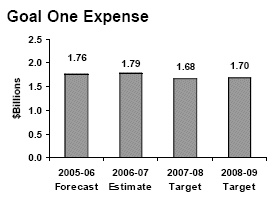 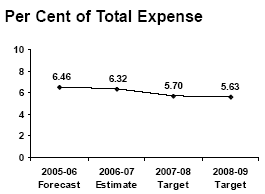
|
The following measures track progress toward achieving Goal
1:
|
|
| 
|
| |
| LEADING
IN LEARNING |
| |

Albertans will be well prepared for lifelong learning and work |
| |
Quality basic and advanced
education, lifelong learning and human resource development enables
Albertans to be responsible, caring, creative, self-reliant and
contributing members of society. The system helps Albertans develop
the learning, work and life skills they need to achieve their aspirations
and maximize their potential. (Progress toward Goal 2 results in
progress being made toward achieving Goals 1, 3, 4, 5, 6 and 7.) |
Three-year strategic focus |
|
The following strategic
priorities address significant opportunities and challenges facing
the government. See the three-year business plans of the ministries
shown in brackets for further information.
- Access for All Learners
(Advanced Education) – Expand regional and community access to
advanced learning opportunities through the strategic application
of technology, expansion of degree-granting capacity within the
system, clarification of roles relative to communities and provision
of the tools necessary to allow learners to succeed.
- Affordability for All Learners
(Advanced Education) – Ensure that Albertans have access to affordable
learning opportunities through policies and programs that are
responsive to the increasingly diverse needs of learners and leverage
high rates of participation among all Albertans, including Aboriginal
learners, rural Albertans, immigrants and those who are socio-economically
disadvantaged.
- Quality and Innovation in
the Advanced Education System (Advanced Education) –
Enhance standards of performance of the advanced education system
through cross-ministry, interprovincial and international collaboration.
Current priorities include Aboriginal education, system capacity
and high standards of excellence in the delivery of degree-program
opportunities.
- Success for All Students
(Education) – Increase the emphasis on continuous improvement
by ensuring effective transitions between school and home and
throughout various phases of schooling, including Kindergarten
to Grade 1 through to high school completion, post-secondary programs
and the world of work, and by implementing the Accountability
Pillar of the Renewed Funding Framework.
- Supporting the Healthy Development
of Alberta’s Children and Youth (Education) – Develop
collaborative health, social and learning programs and services
that ensure children and youth will be well cared for, safe, healthy
and successful at learning.
- First Nations, Métis and
Inuit Student Success (Education) – Provide meaningful
educational opportunities for, and improve the educational attainment
of, First Nations, Métis and Inuit students in provincial schools
through ongoing implementation of the First Nations, Métis and
Inuit Education Policy Framework.
- International and Pan-Canadian
Initiatives (Education) – Enhance educational opportunities
beyond the province’s borders and strengthen intergovernmental
relationships by leading and working collaboratively on the priorities
of the Alberta International Education Strategy.
|
Link to ministry business plans |
|
The following ministries
will dedicate spending toward achieving Goal 2: Advanced Education;
Education; Human Resources and Employment; and Infrastructure and
Transportation. (See the Expense by Goal by Ministry, 2006-07 Estimate
table in the Appendix for spending details.) |
| |
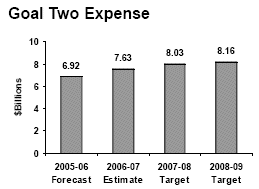 
|
The following measures track progress toward achieving Goal
2:
|
| |
| 
|
| |
| COMPETING
IN A GLOBAL MARKETPLACE |
| |

Alberta's international competitiveness will be enhanced |
| |
Global competitiveness
is key for sustaining the momentum of the Alberta economy. Maintaining
the province’s competitive advantage encourages growth of the province’s
international exports and tourism. Improvement in the skills and
productivity of the workforce is necessary for maintaining and enhancing
Alberta’s competitive advantage. (Progress toward Goal 3 results
in progress being made toward achieving Goals 1, 2 and 7.) |
Three-year
strategic focus |
|
The following strategic
priorities address significant opportunities and challenges facing
the government. See the three-year business plans of the ministries
shown in brackets for further information.
- International Strategy
(Economic Development) – Implement a permanent Provincial Nominee
Program to attract more skilled immigrants through Alberta’s international
initiatives.
- Tourism Development and
Marketing (Economic Development) – Support the expansion
of Alberta’s tourism industry by marketing Alberta as a world-renowned
tourist destination to existing and emerging target markets/audiences
(e.g., China). Develop and enhance new tourism opportunities in
rural Alberta, including Aboriginal initiatives.
- Supporting Economic Development
and Innovation (Infrastructure and Transportation) –
Support Alberta’s growth by providing effective infrastructure
required to sustain growing communities and efficient transportation
to get goods to market. Complete projects such as twinning of
the North-South Trade Corridor and development of urban corridors,
such as the Edmonton and Calgary Ring Roads and other strategic
corridors, to attain increased competitiveness in domestic and
international markets. Plan and develop effective infrastructure
such as new learning, health care and other facilities, as well
as water/wastewater and road network improvements for high-growth
areas such as the Regional Municipality of Wood Buffalo. Continue
to provide support to municipalities and work with stakeholders
to ensure that required infrastructure meets local needs and supports
economic development throughout the province.
|
Link to ministry
business plans |
|
The following ministries
will dedicate spending toward achieving Goal 3: Economic Development;
Human Resources and Employment; Infrastructure and Transportation;
and Sustainable Resource Development. (See the Expense by Goal by
Ministry, 2006-07 Estimate table in the Appendix for spending details.) |
| |
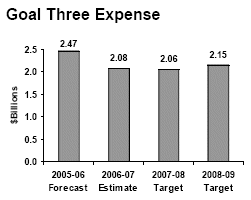 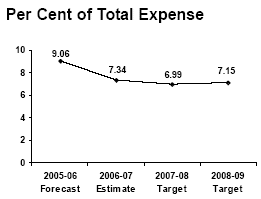
|
The following measures track progress toward achieving Goal
3:
|
|
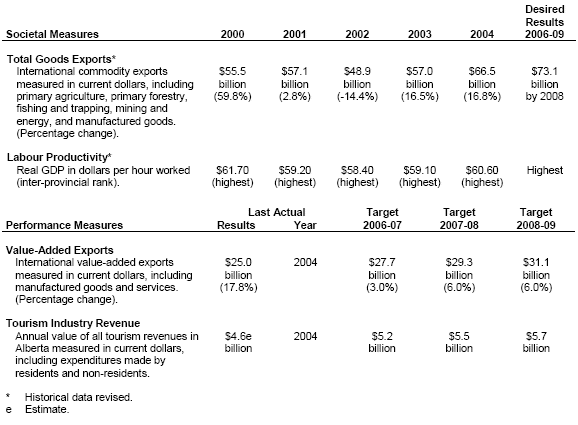
|

|
| |
| MAKING
ALBERTA THE BEST PLACE TO LIVE, WORK AND VISIT |
| |

Alberta's children and youth will be supported in reaching their
potential |
| |
Families
are the foundation for nurturing the development of children and
youth. Although parents have primary responsibility in raising their
children, communities, organizations, schools, businesses and governments
all have supporting roles to play in helping to meet the needs of
Alberta’s children and youth. (Progress toward Goal 4 results in
progress being made toward achieving Goals 2, 6 and 7.) |
Three-year strategic focus |
|
The following strategic
priorities address significant opportunities and challenges facing
the government. See the three-year business plans of the ministries
shown in brackets for further information.
- Improve the outcomes for
children in care or in need of specialized services (Children’s
Services) – Fully operationalize the Family Supports for Children
with Disabilities Act and the Child, Youth and Family
Enhancements Act by 2006 and undertake a review and recommend
adjustments where required. Identify and pursue options to ensure
necessary supports are available for successful transition of
youth to their independence.
- Implement new and/or enhanced
early (learning) child development and child care programs and
services (Children’s Services) – Implement Alberta’s
Early Childhood Development and Child Care Investment Plan. Continue
implementation of the Parent Link Centre framework, building on
existing resources and evaluation of the framework. Continue implementing
an accreditation system for Alberta child care centres and family
day home agencies to assure child development environments are
appropriate.
- Provincial Response to Family
Violence and Bullying (Children’s Services) – Implement
the Strategy for Prevention of Family Violence and Bullying Action
Plan to support individuals, families, communities and governments
to work together toward an Alberta free of family violence and
bullying.
- Implementation of new legislation
(Children’s Services) – Pursue high priority needs of families
and youth that are not adequately addressed by existing legislation,
including drug-endangered children legislation and reviews of
the Protection of Family Violence Act and Social
Care Facilities Licensing Act.
- Improve the range and impact
of preventative strategies (Children’s Services) – Work
with partners and stakeholders to improve the range and impact
of community-based strategies to effectively respond to the needs
of families and children before a crisis develops.
|
Link to ministry business plans |
|
The following ministry
will dedicate spending toward achieving Goal 4: Children’s Services.
(See the Expense by Goal by Ministry, 2006-07 Estimate table in
the Appendix for spending details.) |
| |
 
|
The following measures track progress toward achieving Goal
4:
|
|

|

|
| |

Albertans will be healthy |
| |
Albertans are encouraged
to realize their full health potential through informed lifestyle
choices. The province contributes to the health of Albertans by
advocating and educating for healthy living, providing quality health
and wellness services, and by leading and participating in continuous
improvement of the health care system. (Progress toward Goal 5 results
in progress being made toward achieving Goals 2, 4, 6, 7 and 13.) |
Three-year strategic focus |
|
The following strategic
priorities address significant opportunities and challenges facing
the government. A checkmark ( )
indicates one of the eight Top Priorities of the three-year government
business plan. See the three-year business plans of the ministries
shown in brackets for further information. )
indicates one of the eight Top Priorities of the three-year government
business plan. See the three-year business plans of the ministries
shown in brackets for further information.
 Improving Alberta’s Health System – The Third Way
(Health and Wellness) – Focus on The Third Way priorities to:
address the health, well-being and mental health of children;
control spiraling drug costs and increase coverage; improve quality
of continuing care; and develop recommendations for insurance
program for non-emergency health services. Other cross-ministry
work focusing on The Third Way priorities include: increasing
cross-disciplinary opportunities in health research; and increasing
the availability of addictions services.
Improving Alberta’s Health System – The Third Way
(Health and Wellness) – Focus on The Third Way priorities to:
address the health, well-being and mental health of children;
control spiraling drug costs and increase coverage; improve quality
of continuing care; and develop recommendations for insurance
program for non-emergency health services. Other cross-ministry
work focusing on The Third Way priorities include: increasing
cross-disciplinary opportunities in health research; and increasing
the availability of addictions services. - Wellness and injury prevention
(Health and Wellness) – Encourage Albertans to take greater personal
responsibility for their own health and wellness. By choosing
healthier lifestyles, Albertans will be able to prevent or delay
the onset of chronic conditions.
- Electronic Health Record
- Alberta NetCare (Health and Wellness) – Continue implementation
of an electronic health record for all Albertans by: making diagnostic
images and test results available electronically; launching Alberta
NetCare; and connecting all regions and the majority of physicians
and pharmacists to Alberta NetCare using Alberta SuperNet.
- Continuing care quality
(Health and Wellness) – Improve the quality of continuing care
services by: helping clients navigate through the health system;
improving access to long-term care and home care services; addressing
human resource issues; implementing new standards for long-term
care centres and continuing care services; and enforcing compliance
with the standards.
- Primary health care
(Health and Wellness) – Implement a comprehensive, coordinated
approach to primary health care with appropriate access 24 hours
a day, seven days a week. Emphasizing multi-disciplinary team
delivery will ensure Albertans get the right provider and the
right services at the right time.
- Control spiraling drug costs
and increase coverage (Health and Wellness) – Launch
a study to examine different models for a new Alberta pharmacare
program, including exploring an insurance approach that would
extend coverage to more Albertans. Collaborate with other provinces
and the federal government to launch a national framework for
expensive drugs for rare diseases. Work with neighbouring provinces
to look at establishing a Western Canadian consortium to reduce
costs through bulk buying.
- Access (Health
and Wellness) – Improved access includes waiting time and geographic
access standards and options in health services that meet the
needs of all Albertans.
- Strengthen public health
risk management capabilities (Health and Wellness) –
Strengthen and restructure system capacity to respond to public
health issues and risks.
|
Link to ministry business plans |
|
The following ministries
will dedicate spending toward achieving Goal 5: Finance; Health
and Wellness; Infrastructure and Transportation; and Seniors and
Community Supports. (See the Expense by Goal by Ministry, 2006-07
Estimate table in the Appendix for spending details.) |
| |
 
|
The following measures track progress toward achieving Goal
5:
|
|
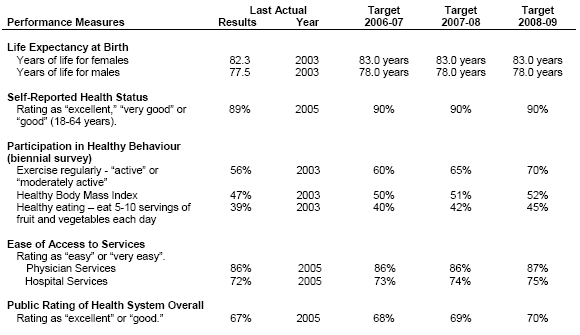
|

|
| |

Albertans will be self-reliant and independent and those unable
to provide for their basic needs will receive help |
| |
Communities,
organizations and governments all have roles in ensuring that Albertans
unable to provide for their basic needs will receive help. Access
to social services and the justice system builds a stronger and
more inclusive society for persons with disabilities, lower-income
Albertans and other Albertans with special needs. Human resource
development is promoted for Albertans to become self-reliant and
independent. (Progress toward Goal 6 results in progress being made
toward achieving Goals 2, 4, 5, 7, 10 and 13.) |
Three-year strategic focus |
|
The following strategic
priorities address significant opportunities and challenges facing
the government. See the three-year business plans of the ministries
shown in brackets for further information.
- Adult Protection
(Seniors and Community Supports) – Undertake a comprehensive review
of protection mechanisms for persons with disabilities in Alberta,
including legislative work with the Dependent Adults Act,
the Personal Directives Act, the Social Care Facilities
Licensing Act, the Protection for Persons in Care Act,
and the Persons with Developmental Disabilities Provincial Board’s
Abuse Prevention and Response Protocol. Establish standards and
compliance mechanisms for accommodation services in supportive
living and long-term care settings. (This priority also supports
Goal 13.)
- Seamless Services (Seniors
and Community Supports) – Streamline access and promote effective
linkages among programs to contribute to simple and seamless service
provision for individuals who need help in meeting their basic
needs and developing or maintaining self-reliance and independence.
This strategic priority is focused on those individuals who are
frequently eligible for benefits and services from more than one
ministry or from several programs within a ministry. (This priority
also supports Goal 13.)
- Legal Aid Service Delivery
(Justice) – Address increased demand for legal aid services through
various strategies, including the implementation of a staff counsel
pilot project in adult criminal court.
- Victims of Crime
(Solicitor General and Public Security) – Further to the approved
recommendations of the MLA Report on the Alberta Victims of Crime
Consultation, develop and enhance programs and services for victims.
|
Link to ministry business plans |
|
The following ministries
will dedicate spending toward achieving Goal 6: Human Resources
and Employment; Justice; Seniors and Community Supports; and Solicitor
General and Public Security. (See the Expense by Goal by Ministry,
2006-07 Estimate table in the Appendix for spending details.) |
| |
 
|
The following measures track progress toward achieving Goal
6:
|
|
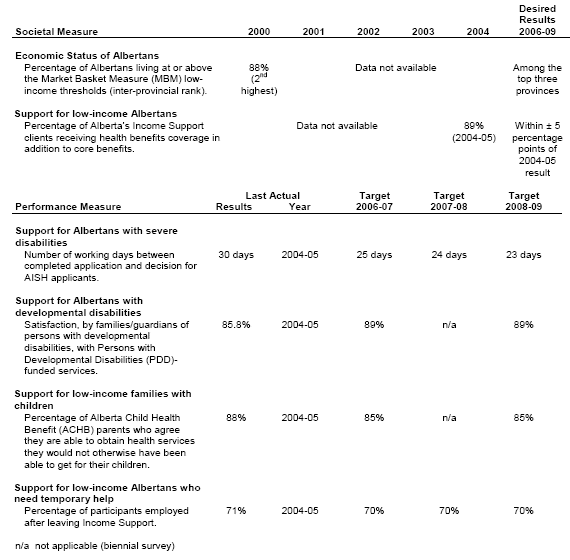
|

|
| |

The well-being and self-reliance of Aboriginal communities and people
will be improved |
| |
Through
Strengthening Relationships: The Government of Alberta’s Aboriginal
Policy Framework, the province is committed to increasing the participation
of Aboriginal people in the social and economic life in Alberta.
Greater inclusion of Aboriginal communities and people will result
in improved quality of life and contribute to the province’s long-term
vision of Alberta as a place where Aboriginal Albertans have achieved
a socio-economic status equivalent to that of other Albertans. (Progress
toward Goal 7 results in progress being made toward achieving Goals
1, 2, 3, 4 and 6.) |
Three-year strategic focus |
|
The
following strategic priorities address significant opportunities
and challenges facing the government. A checkmark ( )
indicates one of the eight Top Priorities of the three-year government
business plan. See the three-year business plans of the ministries
shown in brackets for further information. )
indicates one of the eight Top Priorities of the three-year government
business plan. See the three-year business plans of the ministries
shown in brackets for further information.
 Building
Aboriginal Self-Sufficiency (Aboriginal Affairs and Northern
Development; and Justice) – Implement a framework for, and provide
guidance to, provincial participation in self-government negotiations
with the federal government and First Nations. Establish regulatory
mechanisms to enable economic activity on-reserve. Building
Aboriginal Self-Sufficiency (Aboriginal Affairs and Northern
Development; and Justice) – Implement a framework for, and provide
guidance to, provincial participation in self-government negotiations
with the federal government and First Nations. Establish regulatory
mechanisms to enable economic activity on-reserve. - Consultation
(Aboriginal Affairs and Northern Development) – Develop and implement
a provincial consultation process to ensure that Aboriginal and
treaty rights and traditional use are respected in the management
of Crown lands and resources.
- First
Nations Economic Participation (Aboriginal Affairs and
Northern Development) – Through collaboration with First Nations,
industry and government, implement strategies and develop partnerships
to increase the participation of First Nations in the Alberta
economy.
- Community
Capacity Building (Gaming) – Strengthen communities by
providing grants to First Nations from the First Nations Development
Fund grant program to support economic, social and community development
projects, education, health and infrastructure in First Nations
communities.
|
Link to ministry business plans |
|
The
following ministries will dedicate spending toward achieving Goal
7: Aboriginal Affairs and Northern Development; and Gaming. (See
the Expense by Goal by Ministry, 2006-07 Estimate table in the Appendix
for spending details.) |
| |
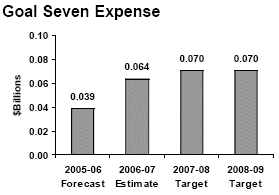 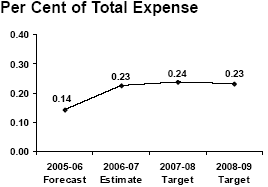
|
The following measures track progress toward achieving Goal
7:
|
|

|

|
| |

Alberta will have a financially stable, open and accountable government |
| |
Financial
stability and a strong public service are essential for the government
to be able to provide the programs and services that are important
to Albertans now and in the future. The province’s credit rating
is a broad measure of the province’s fiscal, economic and political
environment. The government’s commitment to be open and accountable
is legislated in the Government Accountability Act. (Progress
toward Goal 8 results in progress being made toward achieving Goals
1, 3, 9 and 10.) |
Three-year strategic focus |
|
The following strategic
priorities address significant opportunities and challenges facing
the government. A checkmark ( )
indicates one of the eight Top Priorities of the three-year government
business plan. See the three-year business plans of the ministries
shown in brackets for further information. )
indicates one of the eight Top Priorities of the three-year government
business plan. See the three-year business plans of the ministries
shown in brackets for further information.
 Reviewing Tax Policy (Finance) – Build on results
of the current tax review to ensure tax competitiveness, economic
efficiency, fairness and revenue stability.
Reviewing Tax Policy (Finance) – Build on results
of the current tax review to ensure tax competitiveness, economic
efficiency, fairness and revenue stability. - Royalty Systems
(Energy) – Continue to review resource royalty regimes to ensure
that they remain competitive and attractive to investment, that
Albertans continue to receive a fair share of the value of their
energy resources, and that royalty regimes are appropriate for
future resource development, enhanced recovery and technological
innovation.
- Fiscal Framework
(Finance) – Manage the government’s finances to limit financial
risk and provide greater predictability and sustainability. Work
toward implementing the revised Public Sector Accounting Board
recommendations for including all controlled organizations in
the consolidated reporting entity.
- Investments (Finance)
– Seek to enhance investment returns for all government and pension
funds and ensure risks present in the funds are those believed
to lead to superior returns.
- Pensions (Finance)
– Lead the consultation with public sector boards and stakeholders
to review the current governance arrangements for public pension
plans.
- Service Excellence
(Government Services) – Continue commitment to service excellence
and improved service delivery. Through Service Alberta, contribute
to the efficient and convenient delivery of government services
to Albertans by internet, telephone and in person.
- Promote Effective Information
Management (Government
Services) – Implement the Government of Alberta Information Management
Framework for effectively managing information and records, and
mitigating risks regarding the release of confidential information,
focusing initially on electronic records.
- Corporate Human Resource
Development Strategy (Human Resources and Employment
– Personnel Administration Office) – Focus on: enhancing leadership
capacity at all levels of Alberta’s public service; attracting
and retaining talent; fostering positive, safe and healthy work
environments; and helping employees achieve high performance.
- Cross-Government Collaboration
and Shared Solutions (Restructuring and Government Efficiency)
– Continue to focus on a collaborative approach and partnerships
among ministries to enhance service delivery to Albertans by developing
integrated and shared solutions in order to streamline and gain
efficiencies in the business of the government.
|
Link to ministry business plans |
|
The following ministries
will dedicate spending toward achieving Goal 8: Agriculture, Food
and Rural Development; Education; Energy; Executive Council; Finance;
Government Services; Human Resources and Employment (Personnel Administration
Office); Infrastructure and Transportation; Municipal Affairs; Restructuring
and Government Efficiency; and Seniors and Community Supports. This
goal also includes spending of the Legislative Assembly and its
Offices. (See the Expense by Goal by Ministry, 2006-07 Estimate
table in the Appendix for spending details.) |
| |
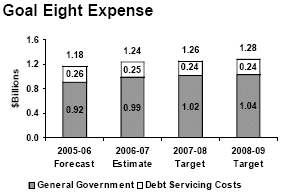 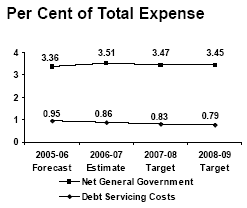
|
The following measures track progress toward achieving Goal
8:
|
|
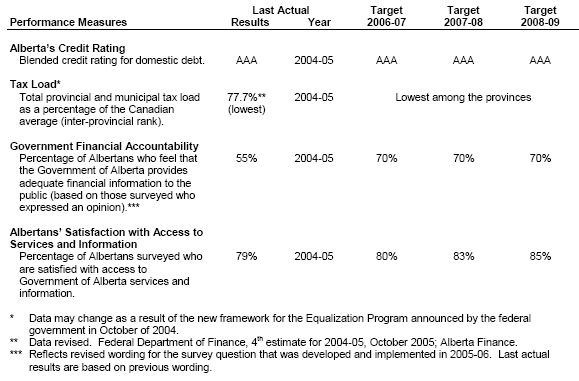
|

|
| |

Alberta will have strong and effective partnerships with municipal,
provincial, territorial, federal and foreign governments |
| |
The
government works to promote the province’s interests as an equal
partner in a strengthened, united Canada, through strengthened international
relations and greater trade and investment liberalization, internationally
and domestically. (Progress toward Goal 9 results in progress being
made toward achieving Goals 1, 3 and 8.) |
Three-year strategic focus |
|
The following strategic
priorities address significant opportunities and challenges facing
the government. See the three-year business plans of the ministries
shown in brackets for further information.
- Canadian Intergovernmental
Relations (International and Intergovernmental Relations)
– Develop coordinated and consistent strategies that advance Alberta’s
interests in intergovernmental issues and processes (e.g., health
care, energy, resource policy, post-secondary education and skills
development, transportation, infrastructure, and fiscal arrangements,
including the fiscal imbalance). Ensure that Alberta’s priorities
are addressed at intergovernmental meetings of First Ministers,
the Premiers’ Council of the Federation, Ministers and officials.
- International Relations
(International and Intergovernmental Relations) – Expand Alberta’s
influence in the United States and globally by strengthening international
relationships with key decision makers through Alberta’s Washington,
D.C. office, and through Premier’s missions, incoming delegations
and major events.
- Trade Policy
(International and Intergovernmental Relations) – Enhance trade
liberalization by removing or reducing barriers to trade, investment
and labour mobility through direct negotiation with the federal
government and other provinces and territories, as well as through
participation in international negotiations (e.g., World Trade
Organization negotiations, bilateral negotiations) and in trade
dispute resolution mechanisms.
- Provincial/Municipal Relationship
(Municipal Affairs) – Work with municipal partners to
reassess and better define the roles and responsibilities of municipal
governments and their relationship with the provincial government.
Subsequently, the most appropriate funding vehicles that affect
these roles and responsibilities will be determined.
- Intermunicipal Partnerships
(Municipal Affairs) – Encourage and facilitate partnerships involving
joint planning, innovation and common opportunities including
shared resourcing in the delivery of services and programs.
|
Link to ministry business plans |
|
The following ministries
will dedicate spending toward achieving Goal 9: Finance; Infrastructure
and Transportation; International and Intergovernmental Relations;
and Municipal Affairs. (See the Expense by Goal by Ministry, 2006-07
Estimate table in the Appendix for spending details.) |
| |
 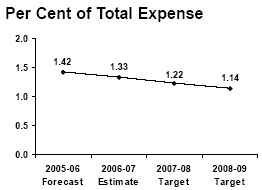
|
The following measures track progress toward achieving Goal
9:
|
|

|

|
| |

Alberta will be a fair and safe place to work, live and raise families |
| |
Albertans
want communities in which they can live and raise families in safety
and security without fear of personal or property crime, victimization
or discrimination. Effective protection of people and property from
wildfire, floods and harmful environmental events is an important
part of this goal. Albertans also want workplaces that are healthy,
fair, safe and stable for employees and employers. (Progress toward
Goal 10 results in progress being made toward achieving Goals 1,
3, 4, 5, 6, and 13.) |
Three-year strategic focus |
|
The following strategic
priorities address significant opportunities and challenges facing
the government. A checkmark ( )
indicates one of the eight Top Priorities of the three-year government
business plan. See the three-year business plans of the ministries
shown in brackets for further information. )
indicates one of the eight Top Priorities of the three-year government
business plan. See the three-year business plans of the ministries
shown in brackets for further information.
 Saving Lives and Reducing Injury on Alberta Highways
(Infrastructure and Transportation; Solicitor General and Public
Security; and Justice) – Implement the new Alberta Traffic Safety
Plan, which provides a coordinated approach for the development
of new strategies, including legislation and increased enforcement
to reduce the number of injuries and deaths on Alberta’s roads.
Through coordinated leadership, address issues related to traffic
safety, driver education and licensing, enforcement, technology
and sustainable funding.
Saving Lives and Reducing Injury on Alberta Highways
(Infrastructure and Transportation; Solicitor General and Public
Security; and Justice) – Implement the new Alberta Traffic Safety
Plan, which provides a coordinated approach for the development
of new strategies, including legislation and increased enforcement
to reduce the number of injuries and deaths on Alberta’s roads.
Through coordinated leadership, address issues related to traffic
safety, driver education and licensing, enforcement, technology
and sustainable funding.  Protecting People’s Private Information (Government
Services; and Restructuring and Government Efficiency) – Develop
a government-wide strategy to ensure personal information entrusted
to government is managed to ensure its privacy and security.
Protecting People’s Private Information (Government
Services; and Restructuring and Government Efficiency) – Develop
a government-wide strategy to ensure personal information entrusted
to government is managed to ensure its privacy and security. - Inclusive Communities
(Community Development) – Foster equality, support the reduction
of discrimination and barriers to full participation in society,
and support the development of inclusive communities and workplaces.
This will be furthered by addressing increasing volumes in human
rights caseloads, emerging workplace issues related to accommodating
disabilities, and developing strategies to support the inclusion
and integration of immigrants and ethnic and racial groups into
Alberta communities and workplaces. Comprehensive and effective
legislation, education and enforcement are also critical to supporting
the protection, inclusion and participation of all Albertans.
- Securities Regulation
(Finance) – Ensure an effective and efficient securities regulatory
system is available in Alberta that meets the needs of Alberta’s
business and investors. Lead and actively promote the development
and implementation of an effective and efficient system of securities
regulation in Canada.
- Ensure a Fair, Competitive
and Orderly Marketplace (Government Services) – Address
emerging marketplace issues, such as mortgage fraud, identity
theft and utility issues. Increase Albertans’ awareness of issues,
respond to their concerns, influence policy direction, offer advice
and intervene in regulatory proceedings.
- Employment Standards (Human
Resources and Employment) – Review Employment Standards to ensure
that applicable legislation and programs support the continued
productivity of Alberta’s workforce while maintaining an effective
balance in employer and employee relationships.
- Family Violence and Protection
of Children (Justice) – Establish the Alberta Relationship
Threat Assessment and Management Initiative to further Alberta’s
progression toward prevention and effective intervention in family
violence. The initiative will provide expert resources to assess
threats and their level of lethality, formulate mitigation strategies,
develop safety plans and conduct death reviews.
- Dispute Resolution
(Justice) – Provide high quality alternate dispute resolution
processes by improving access to alternatives to the traditional
justice system.
- Family Justice Strategy
(Justice) – Provide an alternative to a Unified Family Court with
a focus on developing integrated and appropriate responses to
family law problems. The long-term goal is to have a family law
system that offers a common set of procedures and appropriate
services to all family law applicants.
- Policing (Solicitor
General and Public Security) – Ensure that the police have the
necessary resources to meet both existing and emergent crime and
public safety challenges in an increasingly dangerous environment
and that the police operate under effective civilian oversight.
- Leading Practices (Solicitor
General and Public Security) – Increase focus on ensuring that
correctional, policing and security services reflect international
best or leading practices to further public safety.
- Correctional Services (Solicitor
General and Public Security) – Bring greater efficiency and transparency
to the entire spectrum of correctional services by engaging federal
corrections officials in discussions surrounding the potential
integration of currently shared program delivery responsibility.
- Emergency Management (Municipal
Affairs) – Enhance existing provincial government emergency management
and develop provincial and local capabilities to deal with major
emergencies and disasters. Continue to work on identification
of hazards to critical infrastructure, high-priority issues such
as pandemic influenza and environmental incidents, and business
continuity planning.
- Safety System Enhancement
(Municipal Affairs) – Conduct a review of safety legislation to
ensure it is correct and responsive to changing needs. Introduce
harmonized, objective-based codes in the building, fire and plumbing
disciplines through national and international codes and standards.
Work with stakeholders on developing a unifying framework for
the fire service in Alberta to provide a strong foundation for
innovation.
|
Link to ministry business plans |
|
The following ministries
will dedicate spending toward achieving Goal 10: Community Development;
Finance; Government Services; Human Resources and Employment; Infrastructure
and Transportation; Justice; Municipal Affairs; Solicitor General
and Public Security; and Sustainable Resource Development. (See
the Expense by Goal by Ministry, 2006-07 Estimate table in the Appendix
for spending details.) |
| |
 
|
The following measures track progress toward achieving Goal
10:
|
|
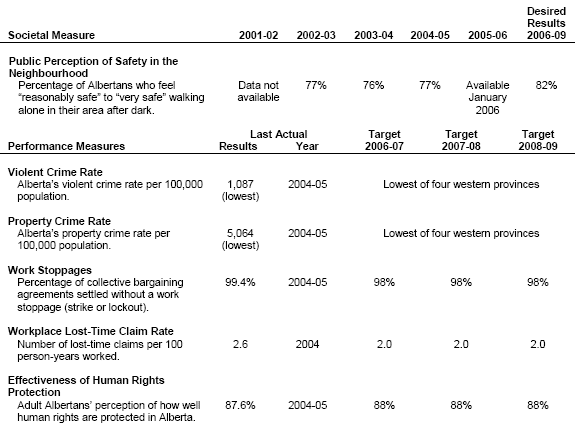
|

|
| |

The high quality of Alberta's environment will be sustained |
| |
Albertans
enjoy many benefits from the environment. Clean air, water and land
are basic to our health, economy, communities and quality of life.
Albertans expect our environment to be managed and protected as
a legacy for future generations. (Progress toward Goal 11 results
in progress being made toward achieving Goals 1, 5, 7, 10 and 12.) |
Three-year strategic focus |
|
The following strategic
priorities address significant opportunities and challenges facing
the government. See the three-year business plans of the ministries
shown in brackets for further information.
- Sustainable Resource and
Environmental Management (SREM) (Sustainable Resource
Development; Environment; and Energy) – Advance government-wide
action on outcome-based management systems, integrated resource
and environmental management policies, shared information systems
and streamlined regulatory processes. SREM will also focus on
policies, guidelines, and practices that work towards minimizing
the industrial, commercial and recreational footprint on public
lands and coordinate environmental and resource information systems
for data and information required across government, by industry
and stakeholders, and by Albertans. It will enhance Albertans’
awareness, understanding and wise use of our natural resources
and environment. (This priority integrates with Using and Respecting
the Land under Goal 1.)
- Water: Albertans have a
Safe and Sustainable Supply of Water (Environment) –
With our partners, effectively manage the quality and quantity
of our water resources and ensure thriving aquatic ecosystems.
Implement the provincial water strategy, Water for Life: Alberta’s
Strategy For Sustainability.
- Climate Change: Alberta
takes Effective Action on Climate Change (Environment)
– Work with other governments, industries and communities towards
innovative and practical long-term solutions. Focus on implementation
of the provincial climate change plan, Albertans & Climate Change:
Taking Action, including actions to reduce greenhouse gas emissions
and strategic investments that help Alberta respond to climate
change while developing a competitive economy.
|
Link to ministry business plans |
|
The following ministries
will dedicate spending toward achieving Goal 11: Energy; Environment;
Infrastructure and Transportation; and Sustainable Resource Development.
(See the Expense by Goal by Ministry, 2006-07 Estimate table in
the Appendix for spending details.) |
| |
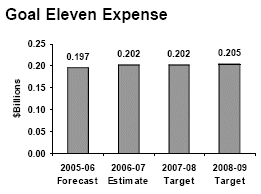 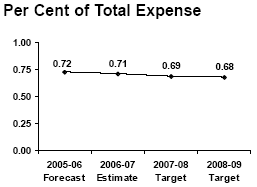
|
The following measures track progress toward achieving Goal
11:
|
|

|

|
| |

Albertans will have the opportunity to participate in community
and cultural activities and enjoy the province's historical resources
and parks and protected areas |
| |
Albertans’
opportunities to participate in community and cultural activities
and their enjoyment of the province’s historical resources and parks
and protected areas are essential elements of a high quality of
life. Albertans value: protecting and preserving Alberta’s provincial
parks, protected areas, history and cultural heritage; building
community capacity; and supporting libraries, the voluntary sector,
sport, recreation and the arts. (Progress toward Goal 12 results
in progress being made toward achieving Goals 1, 2, 4, 5, 7, and
11.) |
Three-year strategic focus |
|
The following strategic
priorities address significant challenges and opportunities facing
the government. See the three-year business plans of the ministries
shown in brackets for further information.
- Community Capacity Building
(Community Development) – Strengthen community resources in support
of libraries, the voluntary sector, sport and recreation and the
arts. This will be addressed by supporting rural sustainability,
developing a voluntary sector framework, addressing recommendations
from the Alberta Sport Plan, furthering the Active Living Strategy
and introducing an inclusive cultural policy.
- Benefiting Albertans
(Gaming) – Increase grant funding to develop and enhance community
facilities, such as libraries, outdoor recreation and playground
projects, and other community-based initiatives through the use
of the Alberta Lottery Fund.
|
Link to ministry business plans |
|
The following ministries
will dedicate spending toward achieving Goal 12: Community Development;
and Gaming. (See the Expense by Goal by Ministry, 2006-07 Estimate
table in the Appendix for spending details.) |
| |
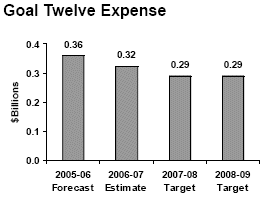 
|
The following measures track progress toward achieving Goal
12:
|
|
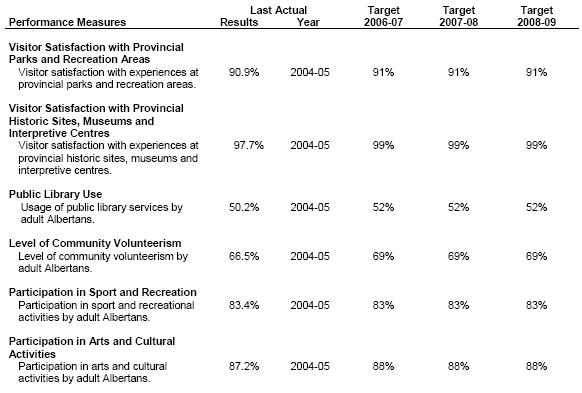
|

|
| |

The vitality and independence of Alberta's seniors will be supported |
| |
Alberta’s
seniors represent a diverse and growing population with a wide array
of expectations, skills, lifestyles and social networks. All of
Alberta benefits when seniors are supported in maintaining their
well-being and independence to control their own lives and make
their own choices. (Progress toward Goal 13 results in progress
being made toward achieving Goals 5, 6, 10 and 12.) |
Three-year strategic focus |
|
Seniors benefit from
the same programs and services as other Albertans. In addition,
the Government of Alberta provides specific programs for seniors,
such as the Alberta Seniors Benefit, Special Needs Assistance for
Seniors, and dental and optical programs. Seniors are also exempt
from Alberta Health Insurance premiums. The following government
strategies are directed at improving the well-being of seniors:
- Delivery Models for Seniors’
Programs (Seniors and Community Supports) – Future seniors
may have different expectations and circumstances than current
seniors. As Alberta’s population ages, it will be important to
forecast, plan and model seniors’ policies and programs to identify
potential changes that are responsive to changing needs.
- Enhanced Safe Supportive
Living Options (Seniors and Community Supports) – Government
will work with stakeholders such as regional health authorities
and housing operators to assist in making supportive living accessible,
safe and affordable for lower-income seniors. In addition, accommodation
standards for supportive living and long-term care settings will
be established, monitored and enforced.
- Supporting Older Albertans
(Seniors and Community Supports) – Alberta’s population is aging,
and increasingly older Albertans will need to have tools, information
and supports to maintain their independence and vitality. Personal
directives are an important tool to help Albertans plan for future
personal decisions. A renewed public education campaign will be
delivered to encourage Albertans to prepare personal directives.
In addition, government will work to explore services and opportunities
for older Albertans in areas such as transportation, employment
retention, retirement planning and elder abuse prevention.
|
Link to ministry business plans |
|
The following ministry
will dedicate spending toward achieving Goal 13: Seniors and Community
Supports. (See the Expense by Goal by Ministry, 2006-07 Estimate
table in the Appendix for spending details.) |
| |
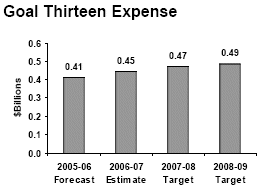 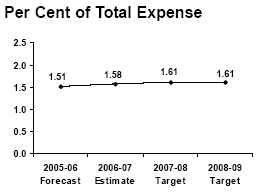
|
The following measures track progress toward achieving Goal
13:
|
|

|

|
| |
| CAPITAL
PLAN |
| |

Alberta will have a supportive and sustainable infrastructure that
promotes growth and enhances quality of life |
| |
Effective
and sustainable infrastructure is essential to achieving the vision
of a vibrant and prosperous province where Albertans enjoy a superior
quality of life. The physical condition of government-owned and
supported infrastructure is a key indicator of its effectiveness
and sustainability. (Progress toward Goal 14 results in progress
being made toward achieving Goals 1, 2, 3, 5, 8, 10, 11, 12 and
13.) |
Three-year strategic focus |
|
The following strategic
priorities address significant opportunities and challenges facing
the government. A checkmark ( )
indicates one of the eight Top Priorities of the three-year government
business plan. See the three-year business plans of the ministries
shown in brackets for further information. )
indicates one of the eight Top Priorities of the three-year government
business plan. See the three-year business plans of the ministries
shown in brackets for further information.
 Building Infrastructure for Our Future (Infrastructure
and Transportation) – Develop a comprehensive 10-year capital
plan to address existing deferred infrastructure maintenance and
future investment in new infrastructure projects.
Building Infrastructure for Our Future (Infrastructure
and Transportation) – Develop a comprehensive 10-year capital
plan to address existing deferred infrastructure maintenance and
future investment in new infrastructure projects. - Post-Secondary Infrastructure
(Advanced Education) – Enhance the infrastructure of
Alberta’s public post-secondary system to facilitate delivery
of high-quality advanced learning opportunities throughout the
province. This includes expansion, modernization and functional
renewal of post-secondary facilities and equipment within the
context of a 10-year capital plan.
- Infrastructure Renewal
(Community Development) – Renew infrastructure for provincial
parks and recreation areas, historic sites, museums and interpretive
centres. This will be addressed by expanding the government’s
capacity to address Alberta’s growing population, repairing or
replacing damaged or deteriorating facilities and equipment, upgrading
water and sewage systems in provincial parks and recreation areas
as part of the Water for Life Strategy, and modernizing the province’s
exhibits and developing its collections to reflect new areas of
interest. Centennial projects will be monitored to their conclusion
to ensure their intended legacy is delivered to Albertans. (This
priority is also linked to Goal 12.)
- Addressing School Infrastructure
Needs (Education) – Provide leadership in the development
of the school capital priority list to meet the educational needs
of Alberta’s students and to ensure that school environments are
well-maintained, safe and support learning success in a changing
demographic environment.
- Health Infrastructure
(Health and Wellness) – Develop and implement long-term capital
plans to ensure Albertans have access to appropriate facilities
and services for health care.
- Managing Complex Infrastructure
Requirements (Infrastructure and Transportation) – Manage
Alberta’s infrastructure requirements effectively and efficiently
in today’s complex global environment by: balancing the need for
ongoing maintenance and rehabilitation of existing capital with
the need for new capital investment; designing a 10-year plan
to eliminate the deferred maintenance backlog; determining priority
capital projects; and considering alternative financing opportunities,
including public-private partnerships, to provide needed infrastructure.
- Alberta SuperNet
(Restructuring and Government Efficiency) – Continue to develop
strategic planning activities for the operation of Alberta SuperNet
that work toward eliminating the digital divide between rural
and urban areas by enabling rural communities, individuals and
businesses to connect to the world.
- Sustainable Housing
(Seniors and Community Supports) – Encourage public, private,
and non-profit housing sectors to work together to develop locally-based
sustainable housing initiatives for lower-income Albertans, persons
with disabilities and other Albertans who have difficulty finding
suitable housing within their means. One-time capital funding
will be provided to community organizations for the development
of housing that does not require ongoing operating subsidies.
|
Link to ministry business plans |
|
The following ministries
will dedicate spending toward achieving Goal 14: Advanced Education;
Agriculture, Food and Rural Development; Children’s Services; Community
Development; Education; Energy; Environment; Finance; Gaming; Government
Services; Health and Wellness; Human Resources and Employment; Infrastructure
and Transportation; Innovation and Science; Justice; Municipal Affairs;
Restructuring and Government Efficiency; Seniors and Community Supports;
and Sustainable Resource Development. (For Capital Plan investment
by ministry details, see the following tables in the 2006-09 Fiscal
Plan: Capital Investment in Government-Owned Capital; and Grants
to Local Authorities for Capital Purposes and Other Capital Support.)
|
| |


|
The following measures track progress toward achieving Goal
14:
|
|
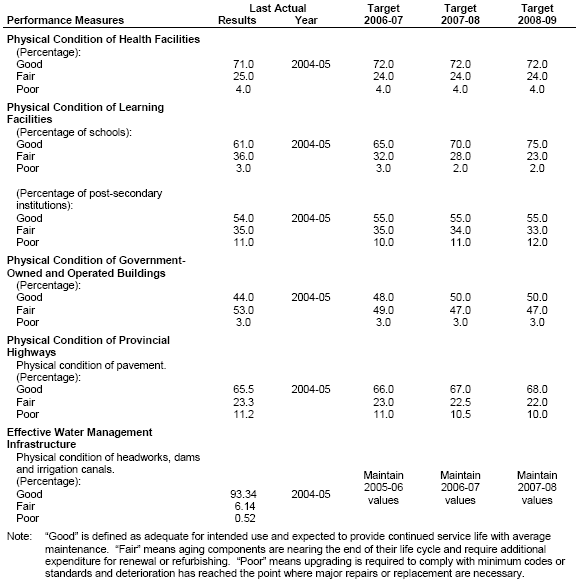
|

|
| |
| APPENDIX |
| |
| EXPENSE
BY GOAL |
 |
| 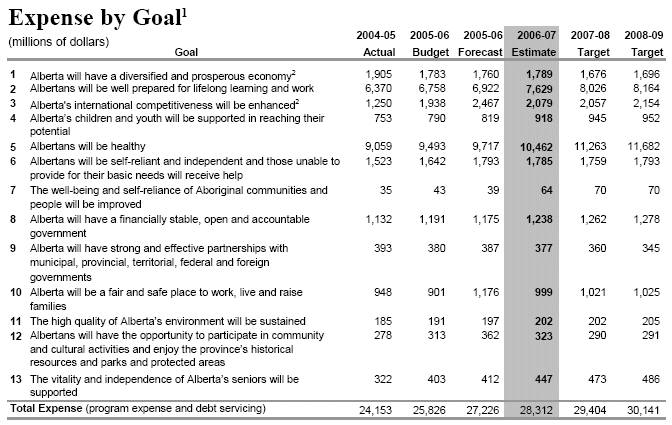

|
| EXPENSE
BY GOAL BY MINISTRY, 2006-07 ESTIMATE |
 |
| 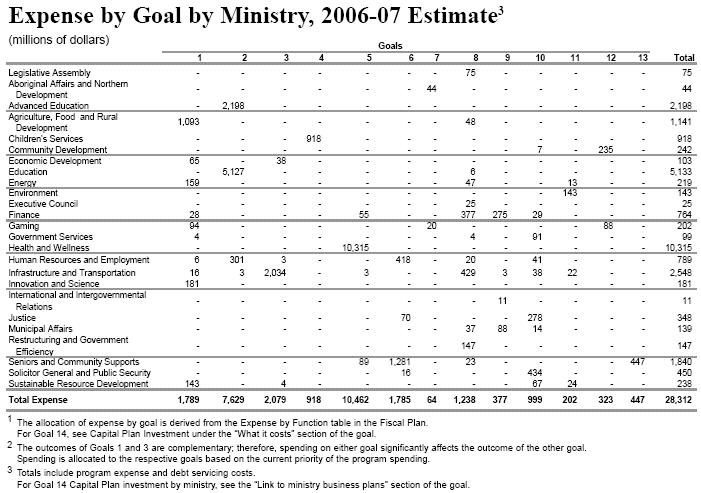

|
| EXPENSE
BY CORE BUSINESS |
 |
| 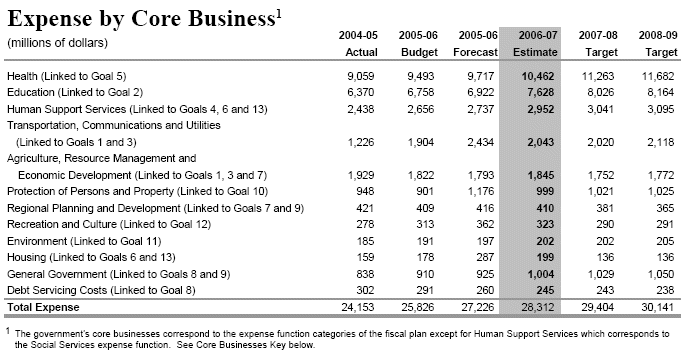

|
| |
| CORE
BUSINESSES KEY |
 |
The
following is a brief description of the general areas of the government's
work for each of its core businesses.
Agriculture, Resource Management
and Economic Development – includes programs and services
related to agriculture, fish and game, oil and gas, forestry, economic
development for industry and trade, tourism and other economic sectors,
labour force development and immigration, and research establishments.
Also includes provincial grants for related capital infrastructure.
Debt Servicing Costs
– includes interest and other charges pertaining to servicing of
the public debt, including debt-servicing costs for accumulated
debt obligations, which are matched to investments locked into the
Debt Retirement Account.
Education – includes
early childhood services to secondary education (e.g., school boards,
schools, teachers, curricula, textbooks and classroom resources),
post-secondary education (e.g., universities, colleges, apprenticeships,
industry training and support to adult learners) and retraining
(skills upgrading). Also includes provincial grants to local authorities
for related capital infrastructure.
Environment – includes
programs and services related to sustainable environmental management,
ensuring safe and adequate supplies of water, actions taken on climate
change and protection of the land.
General Government
– includes the Legislature, the Lieutenant Governor, government
and legislative staff and officials, international and intergovernmental
relations, and general administration (including budgeting and accounting,
tax and revenue collection, and communications).
Health – includes
health services for all Albertans, including hospital services,
medical care, drug programs, preventive care, x-rays, alcohol and
drug rehabilitation, and health services for persons with disabilities.
Also includes provincial grants to local authorities for related
capital infrastructure.
Housing – includes
housing of seniors, low-income families and those with special needs.
Also includes provincial grants for related capital infrastructure.
Human Support Services
– includes services for people in need including child protection
services, income support for adults and seniors, services for victims
of crime, provision of legal aid, supports for people with disabilities
and support for those unable to work due to illness or disability.
Protection of Persons and Property
– includes programs and services related to public security, policing,
the judicial system, human rights, maintenance enforcement, firefighting,
related regulation, labour relations, safe work environments, and
correctional and rehabilitation services.
Recreation and Culture
– includes programs and services related to recreation, sport, culture,
historical artefacts and sites, museums, libraries, and provincial
parks and protected areas. Also includes provincial grants for related
capital infrastructure.
Regional Planning and Development
– includes community and regional development affairs and services
including planning and zoning, Aboriginal communities, and land
claim negotiations and settlements.
Transportation, Communications
and Utilities – includes programs and services related
to provincial transportation including air, road and rail transport,
telecommunications, pipelines, and gas and electricity utilities.
Also includes provincial grants to local authorities for related
capital infrastructure.

|
Go to: Ministry Business Plan Contacts
|
|










